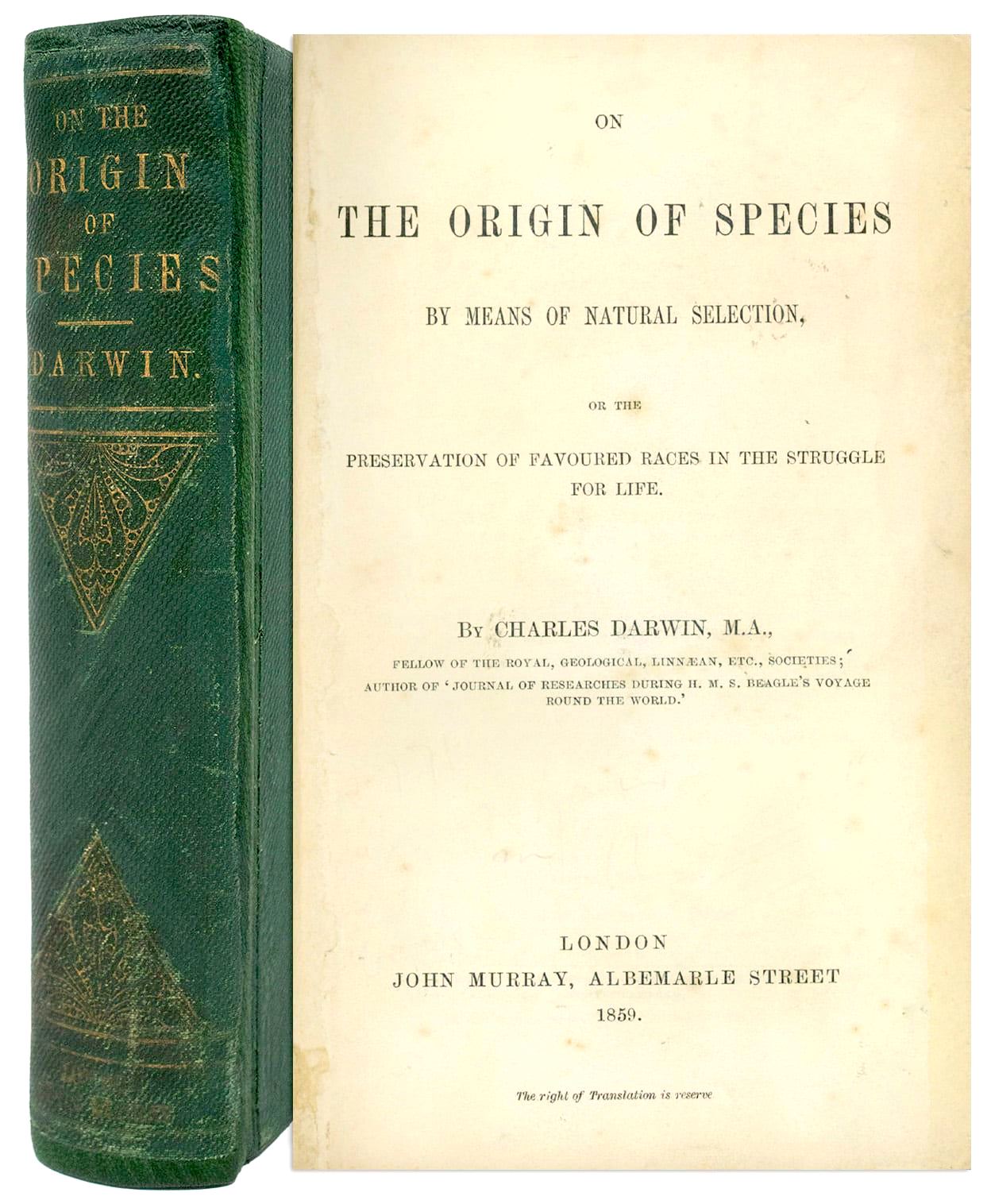
チャールズ・ダーウィン『種の起源について』1859年
On the Origin of Species
☆ 『種の起源について』("On the Origin of Species by Means of Natural Selection, or the Preservation of Favoured Races in the Struggle for Life")は、チャールズ・ダーウィン(1809-1882)による科学 文献で、進化生物学の基礎とされる。1859年11月24日に出版された。ダーウィンの著書は、自然淘汰の過程を通じて個体群が世代を経て進化するという 科学理論を紹介した。本書は、生命の多様性が進化の枝分かれパターンを通じた共通の子孫によって生じたという証拠の数々を提示した。ダーウィンは、 1830年代にビーグル号探検で収集した証拠や、その後の研究、書簡、実験から得た知見を盛り込んだ。
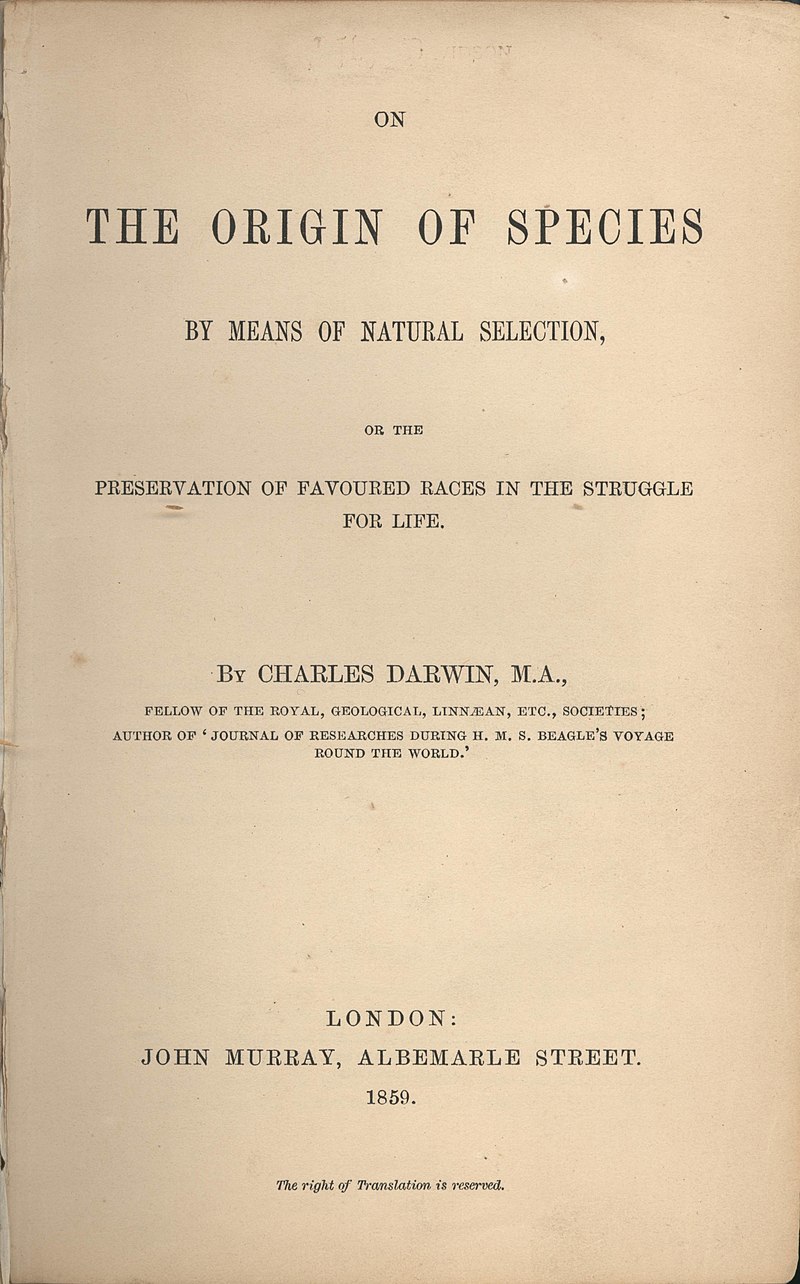 On the Origin of Species
(or, more completely, On the Origin of Species by Means of Natural
Selection, or the Preservation of Favoured Races in the Struggle for
Life)[3] is a work of scientific literature by Charles Darwin that is
considered to be the foundation of evolutionary biology; it was
published on 24 November 1859.[4] Darwin's book introduced the
scientific theory that populations evolve over the course of
generations through a process of natural selection. The book presented
a body of evidence that the diversity of life arose by common descent
through a branching pattern of evolution. Darwin included evidence that
he had collected on the Beagle expedition in the 1830s and his
subsequent findings from research, correspondence, and
experimentation.[5] On the Origin of Species
(or, more completely, On the Origin of Species by Means of Natural
Selection, or the Preservation of Favoured Races in the Struggle for
Life)[3] is a work of scientific literature by Charles Darwin that is
considered to be the foundation of evolutionary biology; it was
published on 24 November 1859.[4] Darwin's book introduced the
scientific theory that populations evolve over the course of
generations through a process of natural selection. The book presented
a body of evidence that the diversity of life arose by common descent
through a branching pattern of evolution. Darwin included evidence that
he had collected on the Beagle expedition in the 1830s and his
subsequent findings from research, correspondence, and
experimentation.[5]Various evolutionary ideas had already been proposed to explain new findings in biology. There was growing support for such ideas among dissident anatomists and the general public, but during the first half of the 19th century the English scientific establishment was closely tied to the Church of England, while science was part of natural theology. Ideas about the transmutation of species were controversial as they conflicted with the beliefs that species were unchanging parts of a designed hierarchy and that humans were unique, unrelated to other animals. The political and theological implications were intensely debated, but transmutation was not accepted by the scientific mainstream. The book was written for non-specialist readers and attracted widespread interest upon its publication. Darwin was already highly regarded as a scientist, so his findings were taken seriously and the evidence he presented generated scientific, philosophical, and religious discussion. The debate over the book contributed to the campaign by T. H. Huxley and his fellow members of the X Club to secularise science by promoting scientific naturalism. Within two decades, there was widespread scientific agreement that evolution, with a branching pattern of common descent, had occurred, but scientists were slow to give natural selection the significance that Darwin thought appropriate. During "the eclipse of Darwinism" from the 1880s to the 1930s, various other mechanisms of evolution were given more credit. With the development of the modern evolutionary synthesis in the 1930s and 1940s, Darwin's concept of evolutionary adaptation through natural selection became central to modern evolutionary theory, and it has now become the unifying concept of the life sciences. |
 『種
の起源について』("On the Origin of Species by Means of Natural Selection, or
the Preservation of Favoured Races in the Struggle for
Life")は、チャールズ・ダーウィンによる科学文献で、進化生物学の基礎とされる。1859年11月24日に出版された。ダーウィンの著書は、自然淘
汰の過程を通じて個体群が世代を経て進化するという科学理論を紹介した。本書は、生命の多様性が進化の枝分かれパターンを通じた共通の子孫によって生じた
という証拠の数々を提示した。ダーウィンは、1830年代にビーグル号探検で収集した証拠や、その後の研究、書簡、実験から得た知見を盛り込んだ。 『種
の起源について』("On the Origin of Species by Means of Natural Selection, or
the Preservation of Favoured Races in the Struggle for
Life")は、チャールズ・ダーウィンによる科学文献で、進化生物学の基礎とされる。1859年11月24日に出版された。ダーウィンの著書は、自然淘
汰の過程を通じて個体群が世代を経て進化するという科学理論を紹介した。本書は、生命の多様性が進化の枝分かれパターンを通じた共通の子孫によって生じた
という証拠の数々を提示した。ダーウィンは、1830年代にビーグル号探検で収集した証拠や、その後の研究、書簡、実験から得た知見を盛り込んだ。生物学における新たな発見を説明するために、すでに様々な進化論的な考え方が提案されていた。反体制派の解剖学者や一般市民の間では、このような考えを支 持する声が高まっていたが、19世紀前半のイギリスの科学界の体制は英国国教会と密接に結びついており、科学は自然神学の一部であった。種の転生に関する 考えは、種は設計された階層の不変の部分であり、人間は他の動物とは無関係な唯一無二の存在であるという信念と対立し、物議を醸した。政治的、神学的な影 響は激しく議論されたが、突然変異は科学の主流には受け入れられなかった。 この本は専門家以外の読者に向けて書かれ、出版と同時に広く関心を集めた。ダーウィンはすでに科学者として高く評価されていたため、彼の発見は真剣に受け 止められ、彼が提示した証拠は科学的、哲学的、宗教的な議論を引き起こした。この本をめぐる議論は、T・H・ハクスリーやXクラブの仲間たちによる、科学 的自然主義を推進することで科学を世俗化しようとする運動に貢献した。20年も経たないうちに、一般的な子孫の分岐パターンを持つ進化が起こったという科 学的合意が広まったが、科学者たちは、ダーウィンが適切と考えた自然淘汰の重要性を与えるのに時間がかかった。1880年代から1930年代までの "ダーウィニズムの蝕 "の間、進化の他のさまざまなメカニズムがより高く評価されるようになった。1930年代から1940年代にかけての現代進化総合学の発展により、自然選 択による進化的適応というダーウィンの概念が現代進化論の中心となり、現在では生命科学の統一概念となっている。 |
Summary of Darwin's theory Darwin pictured shortly before publication Darwin's theory of evolution is based on key facts and the inferences drawn from them, which biologist Ernst Mayr summarised as follows:[6] 1. Every species is fertile enough that if all offspring survived to reproduce, the population would grow (fact). 2. Despite periodic fluctuations, populations remain roughly the same size (fact). 3. Resources such as food are limited and are relatively stable over time (fact). 4. A struggle for survival ensues (inference). 5. Individuals in a population vary significantly from one another (fact). 6. Much of this variation is heritable (fact). 7. Individuals less suited to the environment are less likely to survive and less likely to reproduce; individuals more suited to the environment are more likely to survive and more likely to reproduce and leave their heritable traits to future generations, which produces the process of natural selection (fact). 8. This slowly effected process results in populations changing to adapt to their environments, and ultimately, these variations accumulate over time to form new species (inference). |
ダーウィン理論の概要 出版直前のダーウィン ダーウィンの進化論は、重要な事実とそこから導かれる推論に基づいており、生物学者エルンスト・マイヤーは次のように要約している[6]。 1. すべての種は繁殖可能であり、すべての子孫が繁殖のために生き残った場合、個体数は増加する(事実)。 2. 周期的な変動があるにもかかわらず、個体群の大きさはほぼ同じである(事実)。 3. 食料などの資源は限られており、長期にわたって比較的安定している(事実)。 4. 生存競争が起こる(推論)。 5. 集団内の個体は互いに大きく異なる(事実)。 6. この変異の多くは遺伝する(事実)。 7. 環境に適していない個体は生き残る可能性が低く、繁殖する可能性も低い。一方、環境に適している個体は生き残る可能性が高く、繁殖する可能性も高い(事実)。 8. このゆっくりとしたプロセスの結果、個体群は環境に適応するように変化し、最終的にこれらの変異が時間の経過とともに蓄積され、新しい種が形成される(推論)。 |
| Background See also: History of evolutionary thought and History of biology Developments before Darwin's theory In later editions of the book, Darwin traced evolutionary ideas as far back as Aristotle;[7] the text he cites is a summary by Aristotle of the ideas of the earlier Greek philosopher Empedocles.[8] Early Christian Church Fathers and Medieval European scholars interpreted the Genesis creation narrative allegorically rather than as a literal historical account;[9] organisms were described by their mythological and heraldic significance as well as by their physical form. Nature was widely believed to be unstable and capricious, with monstrous births from union between species, and spontaneous generation of life.[10] 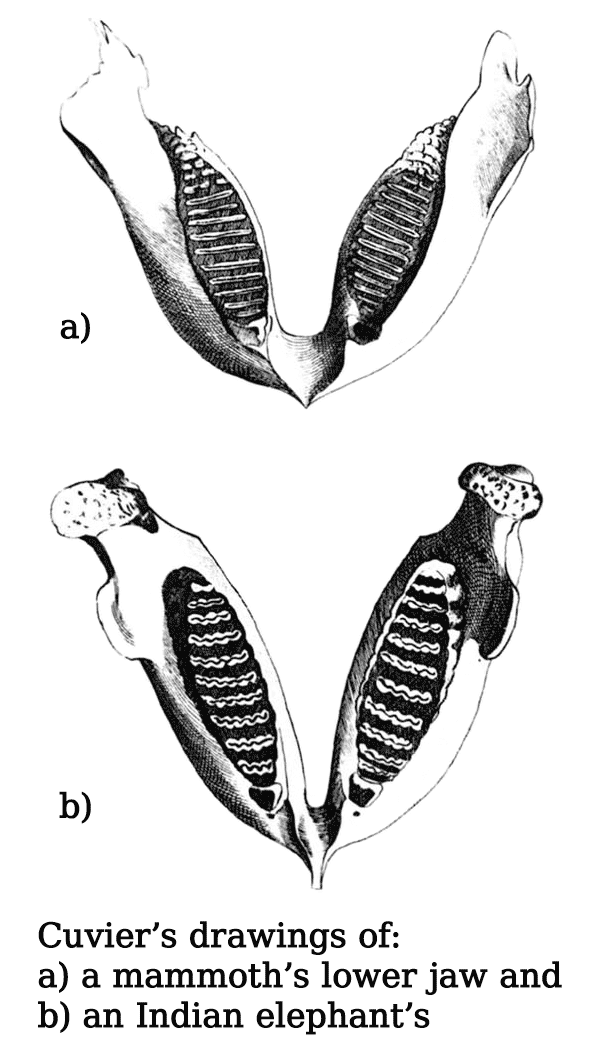 Cuvier's 1799 paper on living and fossil elephants helped establish the reality of extinction. The Protestant Reformation inspired a literal interpretation of the Bible, with concepts of creation that conflicted with the findings of an emerging science seeking explanations congruent with the mechanical philosophy of René Descartes and the empiricism of the Baconian method. After the turmoil of the English Civil War, the Royal Society wanted to show that science did not threaten religious and political stability. John Ray developed an influential natural theology of rational order; in his taxonomy, species were static and fixed, their adaptation and complexity designed by God, and varieties showed minor differences caused by local conditions. In God's benevolent design, carnivores caused mercifully swift death, but the suffering caused by parasitism was a puzzling problem. The biological classification introduced by Carl Linnaeus in 1735 also viewed species as fixed according to the divine plan, but did recognize the hierarchical nature of different taxa. In 1766, Georges Buffon suggested that some similar species, such as horses and asses, or lions, tigers, and leopards, might be varieties descended from a common ancestor. The Ussher chronology of the 1650s had calculated creation at 4004 BC, but by the 1780s geologists assumed a much older world. Wernerians thought strata were deposits from shrinking seas, but James Hutton proposed a self-maintaining infinite cycle, anticipating uniformitarianism.[11] Charles Darwin's grandfather Erasmus Darwin outlined a hypothesis of transmutation of species in the 1790s, and French naturalist Jean-Baptiste Lamarck published a more developed theory in 1809. Both envisaged that spontaneous generation produced simple forms of life that progressively developed greater complexity, adapting to the environment by inheriting changes in adults caused by use or disuse. This process was later called Lamarckism. Lamarck thought there was an inherent progressive tendency driving organisms continuously towards greater complexity, in parallel but separate lineages with no extinction.[12] Geoffroy contended that embryonic development recapitulated transformations of organisms in past eras when the environment acted on embryos, and that animal structures were determined by a constant plan as demonstrated by homologies. Georges Cuvier strongly disputed such ideas, holding that unrelated, fixed species showed similarities that reflected a design for functional needs.[13] His palæontological work in the 1790s had established the reality of extinction, which he explained by local catastrophes, followed by repopulation of the affected areas by other species.[14] In Britain, William Paley's Natural Theology saw adaptation as evidence of beneficial "design" by the Creator acting through natural laws. All naturalists in the two English universities (Oxford and Cambridge) were Church of England clergymen, and science became a search for these laws.[15] Geologists adapted catastrophism to show repeated worldwide annihilation and creation of new fixed species adapted to a changed environment, initially identifying the most recent catastrophe as the biblical flood.[16] Some anatomists such as Robert Grant were influenced by Lamarck and Geoffroy, but most naturalists regarded their ideas of transmutation as a threat to divinely appointed social order.[17] Inception of Darwin's theory See also: Charles Darwin's education and Inception of Darwin's theory Darwin went to Edinburgh University in 1825 to study medicine. In his second year he neglected his medical studies for natural history and spent four months assisting Robert Grant's research into marine invertebrates. Grant revealed his enthusiasm for the transmutation of species, but Darwin rejected it.[18] Starting in 1827, at Cambridge University, Darwin learnt science as natural theology from botanist John Stevens Henslow, and read Paley, John Herschel and Alexander von Humboldt. Filled with zeal for science, he studied catastrophist geology with Adam Sedgwick.[19][20] 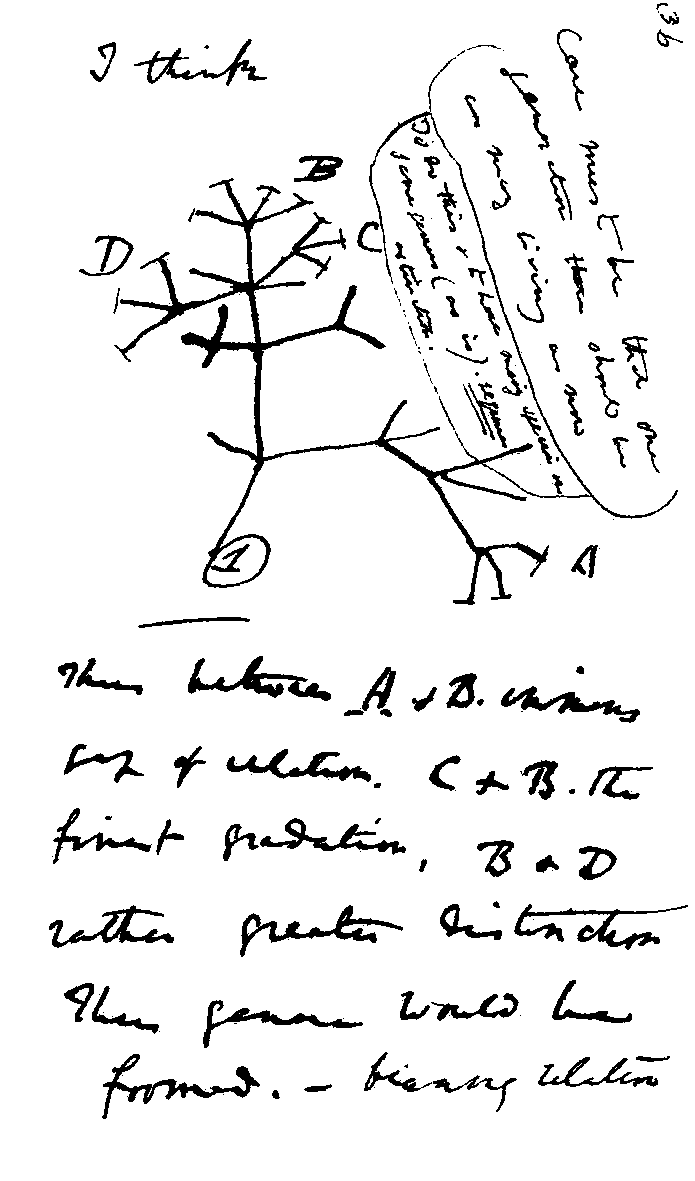 In mid-July 1837 Darwin started his "B" notebook on Transmutation of Species, and on page 36 wrote "I think" above his first evolutionary tree. In December 1831, he joined the Beagle expedition as a gentleman naturalist and geologist. He read Charles Lyell's Principles of Geology and from the first stop ashore, at St. Jago, found Lyell's uniformitarianism a key to the geological history of landscapes. Darwin discovered fossils resembling huge armadillos, and noted the geographical distribution of modern species in hope of finding their "centre of creation".[21] The three Fuegian missionaries the expedition returned to Tierra del Fuego were friendly and civilised, yet to Darwin their relatives on the island seemed "miserable, degraded savages",[22] and he no longer saw an unbridgeable gap between humans and animals.[23] As the Beagle neared England in 1836, he noted that species might not be fixed.[24][25] Richard Owen showed that fossils of extinct species Darwin found in South America were allied to living species on the same continent. In March 1837, ornithologist John Gould announced that Darwin's rhea was a separate species from the previously described rhea (though their territories overlapped), that mockingbirds collected on the Galápagos Islands represented three separate species each unique to a particular island, and that several distinct birds from those islands were all classified as finches.[26] Darwin began speculating, in a series of notebooks, on the possibility that "one species does change into another" to explain these findings, and around July sketched a genealogical branching of a single evolutionary tree, discarding Lamarck's independent lineages progressing to higher forms.[27][28][29] Unconventionally, Darwin asked questions of fancy pigeon and animal breeders as well as established scientists. At the zoo he had his first sight of an ape, and was profoundly impressed by how human the orangutan seemed.[30] In late September 1838, he started reading Thomas Malthus's An Essay on the Principle of Population with its statistical argument that human populations, if unrestrained, breed beyond their means and struggle to survive. Darwin related this to the struggle for existence among wildlife and botanist de Candolle's "warring of the species" in plants; he immediately envisioned "a force like a hundred thousand wedges" pushing well-adapted variations into "gaps in the economy of nature", so that the survivors would pass on their form and abilities, and unfavourable variations would be destroyed.[31][32][33] By December 1838, he had noted a similarity between the act of breeders selecting traits and a Malthusian Nature selecting among variants thrown up by "chance" so that "every part of newly acquired structure is fully practical and perfected".[34] Darwin now had the basic framework of his theory of natural selection, but he was fully occupied with his career as a geologist and held back from compiling it until his book on The Structure and Distribution of Coral Reefs was completed.[35][36] As he recalled in his autobiography, he had "at last got a theory by which to work", but it was only in June 1842 that he allowed himself "the satisfaction of writing a very brief abstract of my theory in pencil".[37] Further development See also: Development of Darwin's theory Darwin continued to research and extensively revise his theory while focusing on his main work of publishing the scientific results of the Beagle voyage.[35] He tentatively wrote of his ideas to Lyell in January 1842;[38] then in June he roughed out a 35-page "Pencil Sketch" of his theory.[39] Darwin began correspondence about his theorising with the botanist Joseph Dalton Hooker in January 1844, and by July had rounded out his "sketch" into a 230-page "Essay", to be expanded with his research results and published if he died prematurely.[40] 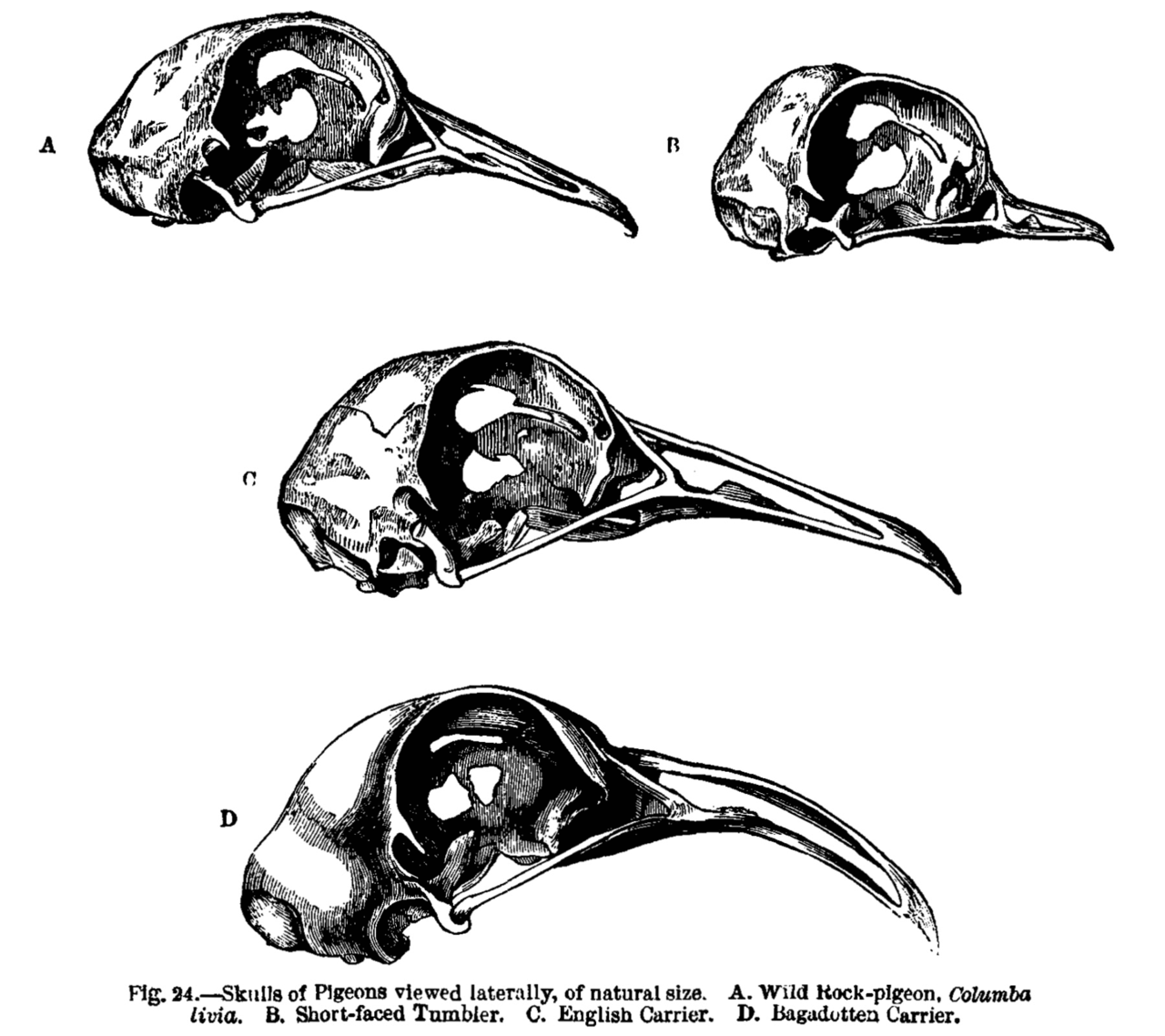 Darwin researched how the skulls of different pigeon breeds varied, as shown in his Variation of Plants and Animals Under Domestication of 1868. In November 1844, the anonymously published popular science book Vestiges of the Natural History of Creation, written by Scottish journalist Robert Chambers, widened public interest in the concept of transmutation of species. Vestiges used evidence from the fossil record and embryology to support the claim that living things had progressed from the simple to the more complex over time. But it proposed a linear progression rather than the branching common descent theory behind Darwin's work in progress, and it ignored adaptation. Darwin read it soon after publication, and scorned its amateurish geology and zoology,[41] but he carefully reviewed his own arguments after leading scientists, including Adam Sedgwick, attacked its morality and scientific errors.[42] Vestiges had significant influence on public opinion, and the intense debate helped to pave the way for the acceptance of the more scientifically sophisticated Origin by moving evolutionary speculation into the mainstream. While few naturalists were willing to consider transmutation, Herbert Spencer became an active proponent of Lamarckism and progressive development in the 1850s.[43] Hooker was persuaded to take away a copy of the "Essay" in January 1847, and eventually sent a page of notes giving Darwin much-needed feedback. Reminded of his lack of expertise in taxonomy, Darwin began an eight-year study of barnacles, becoming the leading expert on their classification. Using his theory, he discovered homologies showing that slightly changed body parts served different functions to meet new conditions, and he found an intermediate stage in the evolution of distinct sexes.[44][45] Darwin's barnacle studies convinced him that variation arose constantly and not just in response to changed circumstances. In 1854, he completed the last part of his Beagle-related writing and began working full-time on evolution. He now realised that the branching pattern of evolutionary divergence was explained by natural selection working constantly to improve adaptation. His thinking changed from the view that species formed in isolated populations only, as on islands, to an emphasis on speciation without isolation; that is, he saw increasing specialisation within large stable populations as continuously exploiting new ecological niches. He conducted empirical research focusing on difficulties with his theory. He studied the developmental and anatomical differences between different breeds of many domestic animals, became actively involved in fancy pigeon breeding, and experimented (with the help of his young son Francis) on ways that plant seeds and animals might disperse across oceans to colonise distant islands. By 1856, his theory was much more sophisticated, with a mass of supporting evidence.[44][46] |
背景 こちらも参照: 進化思想史、生物学史 ダーウィンの理論以前の展開 ダーウィンが引用したテキストは、それ以前のギリシアの哲学者エンペドクレスの考えをアリストテレスが要約したものである[8]。初期キリスト教の教父や 中世ヨーロッパの学者たちは、創世記の天地創造の物語を文字通りの歴史的記述としてではなく、寓意的に解釈した[9]。自然は不安定で気まぐれであり、種 と種の結合による怪物のような誕生や生命の自然発生があると広く信じられていた[10]。  キュヴィエが1799年に発表した、生きているゾウと化石のゾウに関する論文は、絶滅の現実を立証する一助となった。 プロテスタント宗教改革は、ルネ・デカルトの機械的哲学やバコニアン法の経験主義に合致する説明を求める新興科学の知見と対立する創造の概念をもって、聖 書の文字通りの解釈を促した。イギリス内戦の混乱の後、王立協会は科学が宗教的・政治的安定を脅かすものではないことを示したかった。ジョン・レイは、合 理的秩序に関する影響力のある自然神学を発展させた。彼の分類学では、種は静的で固定されたものであり、その適応と複雑さは神によって設計されたものであ る。神の慈悲深い設計では、肉食動物は慈悲深く速やかに死をもたらすが、寄生による苦しみは不可解な問題であった。1735年にカール・リンネが導入した 生物学的分類もまた、神の計画に従って種が固定されたものとみなしたが、異なる分類群の階層的な性質は認識していた。1766年、ジョルジュ・ビュフォン は、馬と驢馬、ライオン、トラ、ヒョウなど、いくつかの類似種は共通の祖先から派生した品種である可能性を示唆した。1650年代のアッシャー年代記で は、天地創造は紀元前4004年とされていたが、1780年代には、地質学者たちはもっと古い世界を想定していた。ウェルネリアンは、地層は縮小する海か ら堆積したものだと考えていたが、ジェームズ・ハットンは、均一主義を先取りして、自己維持する無限のサイクルを提唱した[11]。 チャールズ・ダーウィンの祖父であるエラスマス・ダーウィンは、1790年代に種の転換の仮説を概説し、フランスの博物学者ジャン=バティスト・ラマルク は、1809年にさらに発展した理論を発表した。両者とも、自然発生が単純な生命体を生み出し、それが使用や不使用によって生じた成体の変化を受け継ぐこ とによって環境に適応し、徐々に複雑さを増していくと考えていた。このプロセスは後にラマルク主義と呼ばれるようになった。ジェフロワは、胚の発生は、環 境が胚に作用した過去の時代の生物の変化を再現しており、動物の構造は相同性によって示されるように一定の計画によって決定されると主張した。ジョル ジュ・キュヴィエはこのような考えに強く異論を唱え、関連性のない固定種は機能的な必要性のための設計を反映した類似性を示すとした[13]。1790年 代の彼の古生物学的研究は、絶滅の現実を確立し、彼はそれを局所的な大災害によって説明し、その後、影響を受けた地域に他の種が再繁殖した[14]。 イギリスでは、ウィリアム・ペイリーの自然神学が、自然法則を通して作用する創造主による有益な「デザイン」の証拠として適応を捉えていた。ロバート・グ ラントのような一部の解剖学者はラマルクやジェフロワの影響を受けていたが、ほとんどの自然主義者は彼らの突然変異の考えを、神が定めた社会秩序に対する 脅威とみなしていた[17]。 ダーウィン理論の始まり 以下も参照: チャールズ・ダーウィンの教育、ダーウィン理論の始まり ダーウィンは医学を学ぶために1825年にエジンバラ大学に入学した。2年目には医学をおろそかにして博物学を学び、ロバート・グラントの海洋無脊椎動物 の研究を4ヶ月間手伝った。1827年からケンブリッジ大学で、ダーウィンは植物学者ジョン・スティーヴンス・ヘンズローから自然神学としての科学を学 び、ペイリー、ジョン・ハーシェル、アレクサンダー・フォン・フンボルトを読んだ。科学への熱意に満たされた彼は、アダム・セジウィックのもとで破局主義 的な地質学を学んだ[19][20]。  1837年7月中旬、ダーウィンは種の変容に関するノート「B」を書き始め、36ページには最初の進化の木の上に「私は思う」と書いた。 1831年12月、彼は紳士博物学者、地質学者としてビーグル号探検隊に参加した。彼はチャールズ・ライエルの『地質学の原理』を読み、最初の寄港地であ るセント・ジェーゴでライエルの一様主義が地質学的景観史の鍵であることを知った。ダーウィンは巨大なアルマジロに似た化石を発見し、「創造の中心」を見 つけることを期待して、現代の種の地理的分布に注目した。 [21]探検隊がティエラ・デル・フエゴに帰還させた3人のフエギ人宣教師は友好的で文明的であったが、ダーウィンには島の彼らの親類が「惨めで劣悪な野 蛮人」に見え[22]、人間と動物との間にもはや埋めがたい隔たりがあるとは思えなかった[23]。1836年にビーグル号がイギリスに近づくにつれ、彼 は種が固定されていないかもしれないと指摘した[24][25]。 リチャード・オーウェンは、ダーウィンが南米で発見した絶滅種の化石が、同じ大陸に生息する現生種と同種であることを示した。1837年3月、鳥類学者 ジョン・グールドは、ダーウィンのレアは以前に記載されたレアとは別種であること(ただし、両者の生息域は重なっていた)、ガラパゴス諸島で採集された モッキンバードはそれぞれ特定の島に固有の3つの別種であること、そしてそれらの島で採集されたいくつかの別種の鳥はすべてフィンチとして分類されること を発表した[26]。 [26]ダーウィンは一連のノートの中で、これらの発見を説明するために、「ある種が別の種に変化する」という可能性について推測を始め、7月頃には、ラ マルクの独立した系統がより高い形態へと進歩していくことを捨てて、単一の進化樹の系図をスケッチした[27][28][29]。 ダーウィンは型破りにも、確立された科学者だけでなく、ファンシーなハトや動物の飼育者にも質問をした。動物園で彼は初めて類人猿を目にし、オランウータ ンがいかに人間的であるかに深い感銘を受けた[30]。 1838年9月下旬、ダーウィンはトマス・マルサスの『人口原理に関する試論』を読み始める。ダーウィンはこれを、野生動物の生存競争や植物学者ド・カン ドールの植物における「種の争い」と関連づけた。彼はすぐに、よく適応した変異を「自然の経済の隙間」に押し込む「10万のくさびのような力」を思い描い た。 [31][32][33]。1838年12月までにダーウィンは、育種家が形質を選択する行為と、マルサス的自然が「偶然」によって生み出された変種の中 から「新しく獲得された構造のあらゆる部分が完全に実用化され完成される」ように選択する行為との類似性に着目していた[34]。 ダーウィンは自然淘汰の理論の基本的な枠組みを手に入れたが、地質学者としてのキャリアで手一杯であったため、『サンゴ礁の構造と分布』に関する本が完成 するまで、その理論の編纂を控えていた[35][36]。 自伝の中で回想しているように、彼は「ついに仕事をするための理論を手に入れた」のであったが、「自分の理論のごく簡単な要旨を鉛筆で書くという満足感」 を得たのは1842年6月のことであった[37]。 さらなる発展 以下も参照: ダーウィン理論の発展 ダーウィンは、ビーグル号航海の科学的成果を出版するという主な仕事に集中しながら、自分の理論の研究と大幅な改訂を続けた[35]。 [39]ダーウィンは1844年1月に植物学者のジョセフ・ダルトン・フッカーと自分の理論について文通を始め、7月までに「スケッチ」を230ページの 「エッセイ」にまとめ、研究結果を加えて増補し、早死にした場合には出版する予定であった[40]。  ダーウィンは、1868年の『家畜化された動植物の変異(Variation of Plants and Animals Under Domestication)』に示されているように、異なる品種のハトの頭蓋骨がどのように変化するかを研究した。 1844年11月、スコットランドのジャーナリスト、ロバート・チェンバースによって匿名で出版された大衆科学書『天地創造の自然史』(Vestiges of the Natural History of Creation)は、種の転変という概念に対する人々の関心を広めた。Vestiges』は、化石記録や発生学から得られた証拠を用いて、生物は時間の 経過とともに単純なものからより複雑なものへと進歩してきたという主張を支持した。しかし、ダーウィンの進行中の研究の背後にある枝分かれする共通子孫説 ではなく、直線的な進行を提案し、適応を無視していた。ダーウィンは出版後すぐにこの本を読み、その素人じみた地質学と動物学を軽蔑したが[41]、アダ ム・セジウィックをはじめとする一流の科学者がその道徳性と科学的誤りを攻撃した後、彼自身の主張を慎重に見直した[42]。突然変異を考慮する自然学者 はほとんどいなかったが、ハーバート・スペンサーは1850年代にラマルク主義と漸進的発展の積極的な支持者となった[43]。 フッカーは、1847年1月に「エッセイ」のコピーを持ち帰るよう説得され、最終的にはダーウィンに必要なフィードバックを与えるメモのページを送った。 ダーウィンは分類学の専門知識がないことを思い知らされ、フジツボの研究を8年間始め、フジツボの分類の第一人者となった。ダーウィンは自分の理論を用い て、わずかに変化した体の部位が新しい条件に対応するために異なる機能を果たすことを示す相同性を発見し、明確な性の進化における中間段階を見出した [44][45]。 ダーウィンのフジツボの研究は、変化する状況に対応するだけでなく、絶えず変異が生じることを確信させた。1854年、ダーウィンはビーグル号関連の著作 の最後の部分を完成させ、進化に関する本格的な研究を開始した。彼は今、進化の分岐パターンは、適応を向上させるために絶えず働く自然淘汰によって説明で きることに気づいた。彼の考え方は、島嶼のように孤立した個体群でのみ種が形成されるという見解から、孤立を伴わない種分化に重点を置くものへと変化し た。つまり、彼は大規模で安定した個体群内で特殊化が進み、新しい生態学的ニッチを継続的に開拓していると考えたのである。彼は自身の理論の難点に焦点を 当てた実証的研究を行った。彼は多くの家畜の異なる品種間の発育や解剖学的差異を研究し、空想的な鳩の繁殖に積極的に関わり、植物の種子や動物が海を渡っ て分散し、遠くの島々を植民地化する方法について(幼い息子フランシスの助けを借りて)実験を行った。1856年までには、彼の理論はより洗練され、多く の裏付けとなる証拠が揃っていた[44][46]。 |
| Publication Main article: Publication of Darwin's theory Time taken to publish In his autobiography, Darwin said he had "gained much by my delay in publishing from about 1839, when the theory was clearly conceived, to 1859; and I lost nothing by it".[47] On the first page of his 1859 book he noted that, having begun work on the topic in 1837, he had drawn up "some short notes" after five years, had enlarged these into a sketch in 1844, and "from that period to the present day I have steadily pursued the same object."[48][49] Various biographers have proposed that Darwin avoided or delayed making his ideas public for personal reasons. Reasons suggested have included fear of religious persecution or social disgrace if his views were revealed, and concern about upsetting his clergymen naturalist friends or his pious wife Emma. Charles Darwin's illness caused repeated delays. His paper on Glen Roy had proved embarrassingly wrong, and he may have wanted to be sure he was correct. David Quammen has suggested all these factors may have contributed, and notes Darwin's large output of books and busy family life during that time.[50] A more recent study by science historian John van Wyhe has determined that the idea that Darwin delayed publication only dates back to the 1940s, and Darwin's contemporaries thought the time he took was reasonable. Darwin always finished one book before starting another. While he was researching, he told many people about his interest in transmutation without causing outrage. He firmly intended to publish, but it was not until September 1854 that he could work on it full-time. His 1846 estimate that writing his "big book" would take five years proved optimistic.[48] Events leading to publication: "big book" manuscript 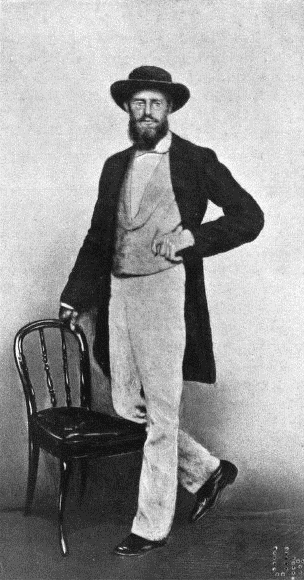 A photograph of Alfred Russel Wallace (1823–1913) taken in Singapore in 1862 An 1855 paper on the "introduction" of species, written by Alfred Russel Wallace, claimed that patterns in the geographical distribution of living and fossil species could be explained if every new species always came into existence near an already existing, closely related species.[51] Charles Lyell recognised the implications of Wallace's paper and its possible connection to Darwin's work, although Darwin did not, and in a letter written on 1–2 May 1856 Lyell urged Darwin to publish his theory to establish priority. Darwin was torn between the desire to set out a full and convincing account and the pressure to quickly produce a short paper. He met Lyell, and in correspondence with Joseph Dalton Hooker affirmed that he did not want to expose his ideas to review by an editor as would have been required to publish in an academic journal. He began a "sketch" account on 14 May 1856, and by July had decided to produce a full technical treatise on species as his "big book" on Natural Selection. His theory including the principle of divergence was complete by 5 September 1857 when he sent Asa Gray a brief but detailed abstract of his ideas.[52][53] Joint publication of papers by Wallace and Darwin Darwin was hard at work on the manuscript for his "big book" on Natural Selection, when on 18 June 1858 he received a parcel from Wallace, who stayed on the Maluku Islands (Ternate and Gilolo). It enclosed twenty pages describing an evolutionary mechanism, a response to Darwin's recent encouragement, with a request to send it on to Lyell if Darwin thought it worthwhile. The mechanism was similar to Darwin's own theory.[52] Darwin wrote to Lyell that "your words have come true with a vengeance, ... forestalled" and he would "of course, at once write and offer to send [it] to any journal" that Wallace chose, adding that "all my originality, whatever it may amount to, will be smashed".[54] Lyell and Hooker agreed that a joint publication putting together Wallace's pages with extracts from Darwin's 1844 Essay and his 1857 letter to Gray should be presented at the Linnean Society, and on 1 July 1858, the papers entitled On the Tendency of Species to form Varieties; and on the Perpetuation of Varieties and Species by Natural Means of Selection, by Wallace and Darwin respectively, were read out but drew little reaction. While Darwin considered Wallace's idea to be identical to his concept of natural selection, historians have pointed out differences. Darwin described natural selection as being analogous to the artificial selection practised by animal breeders, and emphasised competition between individuals; Wallace drew no comparison to selective breeding, and focused on ecological pressures that kept different varieties adapted to local conditions.[55][56][57] Some historians have suggested that Wallace was actually discussing group selection rather than selection acting on individual variation.[58] Abstract of Species book Soon after the meeting, Darwin decided to write "an abstract of my whole work" in the form of one or more papers to be published by the Linnean Society, but was concerned about "how it can be made scientific for a Journal, without giving facts, which would be impossible." He asked Hooker how many pages would be available, but "If the Referees were to reject it as not strictly scientific I would, perhaps publish it as pamphlet."[59][60] He began his "abstract of Species book" on 20 July 1858, while on holiday at Sandown,[61] and wrote parts of it from memory, while sending the manuscripts to his friends for checking.[62] By early October, he began to "expect my abstract will run into a small volume, which will have to be published separately."[63] Over the same period, he continued to collect information and write large fully detailed sections of the manuscript for his "big book" on Species, Natural Selection.[59] Murray as publisher; choice of title 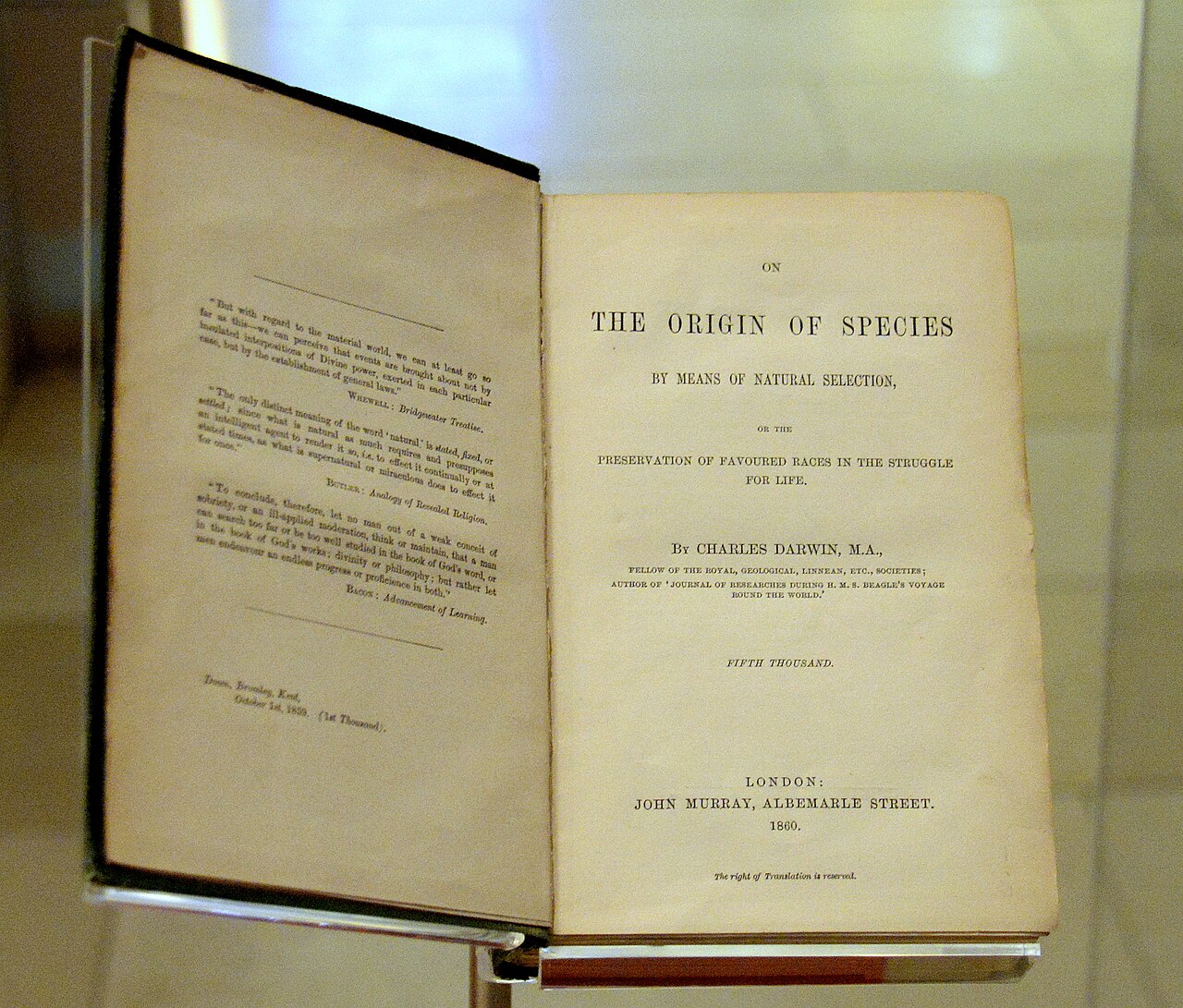 On the Origin of Species by means of Natural Selection, or the Preservation of Favoured Races in the Struggle for Life, 2nd edition. By Charles Darwin, John Murray, London, 1860. National Museum of Scotland. By mid-March 1859 Darwin's abstract had reached the stage where he was thinking of early publication; Lyell suggested the publisher John Murray, and met with him to find if he would be willing to publish. On 28 March Darwin wrote to Lyell asking about progress, and offering to give Murray assurances "that my Book is not more un-orthodox, than the subject makes inevitable." He enclosed a draft title sheet proposing An abstract of an Essay on the Origin of Species and Varieties Through natural selection, with the year shown as "1859".[64][65] Murray's response was favourable, and a very pleased Darwin told Lyell on 30 March that he would "send shortly a large bundle of M.S. but unfortunately I cannot for a week, as the three first chapters are in three copyists' hands". He bowed to Murray's objection to "abstract" in the title, though he felt it excused the lack of references, but wanted to keep "natural selection" which was "constantly used in all works on Breeding", and hoped "to retain it with Explanation, somewhat as thus",— Through Natural Selection or the preservation of favoured races.[65][66] On 31 March Darwin wrote to Murray in confirmation, and listed headings of the 12 chapters in progress: he had drafted all except "XII. Recapitulation & Conclusion".[67] Murray responded immediately with an agreement to publish the book on the same terms as he published Lyell, without even seeing the manuscript: he offered Darwin ⅔ of the profits.[68] Darwin promptly accepted with pleasure, insisting that Murray would be free to withdraw the offer if, having read the chapter manuscripts, he felt the book would not sell well[69] (eventually Murray paid £180 to Darwin for the first edition and by Darwin's death in 1882 the book was in its sixth edition, earning Darwin nearly £3000[70]). On 5 April, Darwin sent Murray the first three chapters, and a proposal for the book's title.[71] An early draft title page suggests On the Mutability of Species.[72] Murray cautiously asked Whitwell Elwin to review the chapters.[59] At Lyell's suggestion, Elwin recommended that, rather than "put forth the theory without the evidence", the book should focus on observations upon pigeons, briefly stating how these illustrated Darwin's general principles and preparing the way for the larger work expected shortly: "Every body is interested in pigeons."[73] Darwin responded that this was impractical: he had only the last chapter still to write.[74] In September the main title still included "An essay on the origin of species and varieties", but Darwin now proposed dropping "varieties".[75] With Murray's persuasion, the title was eventually agreed as On the Origin of Species, with the title page adding by Means of Natural Selection, or the Preservation of Favoured Races in the Struggle for Life.[3] In this extended title (and elsewhere in the book) Darwin used the biological term "races" interchangeably with "varieties", meaning varieties within a species.[76][77] He used the term broadly,[78] and as well as discussions of "the several races, for instance, of the cabbage" and "the hereditary varieties or races of our domestic animals and plants",[79] there are three instances in the book where the phrase "races of man" is used, referring to races of humans.[80] Publication and subsequent editions On the Origin of Species was first published on Thursday 24 November 1859, priced at fifteen shillings with a first printing of 1250 copies.[81] The book had been offered to booksellers at Murray's autumn sale on Tuesday 22 November, and all available copies had been taken up immediately. In total, 1,250 copies were printed but after deducting presentation and review copies, and five for Stationers' Hall copyright, around 1,170 copies were available for sale.[2] Significantly, 500 were taken by Mudie's Library, ensuring that the book promptly reached a large number of subscribers to the library.[82] The second edition of 3,000 copies was quickly brought out on 7 January 1860,[83] and incorporated numerous corrections as well as a response to religious objections by the addition of a new epigraph on page ii, a quotation from Charles Kingsley, and the phrase "by the Creator" added to the closing sentence.[84] During Darwin's lifetime the book went through six editions, with cumulative changes and revisions to deal with counter-arguments raised. The third edition came out in 1861, with a number of sentences rewritten or added and an introductory appendix, An Historical Sketch of the Recent Progress of Opinion on the Origin of Species.[85] In response to objections that the origin of life was unexplained, Darwin pointed to acceptance of Newton's law even though the cause of gravity was unknown, and Leibnitz had accused Newton of introducing "occult qualities & miracles".[86][87] The fourth edition in 1866 had further revisions. The fifth edition, published on 10 February 1869, incorporated more changes and for the first time included the phrase "survival of the fittest", which had been coined by the philosopher Herbert Spencer in his Principles of Biology (1864).[88] In January 1871, George Jackson Mivart's On the Genesis of Species listed detailed arguments against natural selection, and claimed it included false metaphysics.[89] Darwin made extensive revisions to the sixth edition of the Origin (this was the first edition in which he used the word "evolution" which had commonly been associated with embryological development, though all editions concluded with the word "evolved"[90][91]), and added a new chapter VII, Miscellaneous objections, to address Mivart's arguments.[2][92] The sixth edition was published by Murray on 19 February 1872 as The Origin of Species, with "On" dropped from the title. Darwin had told Murray of working men in Lancashire clubbing together to buy the fifth edition at 15 shillings and wanted it made more widely available; the price was halved to 7s 6d by printing in a smaller font. It includes a glossary compiled by W.S. Dallas. Book sales increased from 60 to 250 per month.[3][92] Publication outside Great Britain 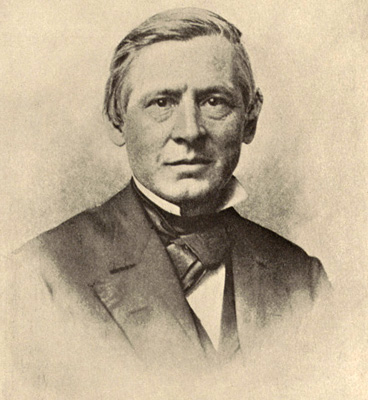 American botanist Asa Gray (1810–1888) In the United States, botanist Asa Gray, an American colleague of Darwin, negotiated with a Boston publisher for publication of an authorised American version, but learnt that two New York publishing firms were already planning to exploit the absence of international copyright to print Origin.[93] Darwin was delighted by the popularity of the book, and asked Gray to keep any profits.[94] Gray managed to negotiate a 5% royalty with Appleton's of New York,[95] who got their edition out in mid-January 1860, and the other two withdrew. In a May letter, Darwin mentioned a print run of 2,500 copies, but it is not clear if this referred to the first printing only, as there were four that year.[2][96] The book was widely translated in Darwin's lifetime, but problems arose with translating concepts and metaphors, and some translations were biased by the translator's own agenda.[97] Darwin distributed presentation copies in France and Germany, hoping that suitable applicants would come forward, as translators were expected to make their own arrangements with a local publisher. He welcomed the distinguished elderly naturalist and geologist Heinrich Georg Bronn, but the German translation published in 1860 imposed Bronn's own ideas, adding controversial themes that Darwin had deliberately omitted. Bronn translated "favoured races" as "perfected races", and added essays on issues including the origin of life, as well as a final chapter on religious implications partly inspired by Bronn's adherence to Naturphilosophie.[98] In 1862, Bronn produced a second edition based on the third English edition and Darwin's suggested additions, but then died of a heart attack.[99] Darwin corresponded closely with Julius Victor Carus, who published an improved translation in 1867.[100] Darwin's attempts to find a translator in France fell through, and the translation by Clémence Royer published in 1862 added an introduction praising Darwin's ideas as an alternative to religious revelation and promoting ideas anticipating social Darwinism and eugenics, as well as numerous explanatory notes giving her own answers to doubts that Darwin expressed. Darwin corresponded with Royer about a second edition published in 1866 and a third in 1870, but he had difficulty getting her to remove her notes and was troubled by these editions.[99][101] He remained unsatisfied until a translation by Edmond Barbier was published in 1876.[2] A Dutch translation by Tiberius Cornelis Winkler was published in 1860.[102] By 1864, additional translations had appeared in Italian and Russian.[97] In Darwin's lifetime, Origin was published in Swedish in 1871,[103] Danish in 1872, Polish in 1873, Hungarian in 1873–1874, Spanish in 1877 and Serbian in 1878. By 1977, Origin had appeared in an additional 18 languages,[104] including Chinese by Ma Chün-wu who added non-Darwinian ideas; he published the preliminaries and chapters 1–5 in 1902–1904, and his complete translation in 1920.[105][106] |
出版 主な記事 ダーウィン理論の出版 出版に要した時間 ダーウィンは自伝の中で、「理論が明確に考え出された1839年頃から1859年まで出版が遅れたことによって多くのものを得たが、それによって失ったも のは何もない」と述べている[47]。 1859年の著書の最初のページでは、1837年にこのテーマについて研究を始め、5年後に「いくつかの短いメモ」を作成し、1844年にそれをスケッチ に拡大し、「その時期から今日まで、私は同じ目的を着実に追求してきた」と述べている[48][49]。 様々な伝記作家が、ダーウィンは個人的な理由から自分の考えを公にすることを避けたり、遅らせたりしたと提唱している。その理由としては、自分の考えが明 らかになった場合の宗教的迫害や社会的不名誉への恐れ、聖職者である博物学者の友人や敬虔な妻エマを動揺させることへの懸念などが指摘されている。チャー ルズ・ダーウィンの病気は度重なる遅れを引き起こした。グレン・ロイに関する彼の論文は恥ずかしくなるほど間違っていることが判明しており、彼は自分が正 しいことを確かめたかったのかもしれない。デイヴィッド・クァンメンは、これらすべての要因が関係している可能性を示唆し、その時期のダーウィンの大量の 著作と多忙な家庭生活を指摘している[50]。 科学史家ジョン・ファン・ワイエによるより最近の研究では、ダーウィンが出版を遅らせたという考えは1940年代にまでさかのぼるものであり、ダーウィン の同時代の人々は、ダーウィンが要した時間は妥当であると考えていた。ダーウィンはいつも1冊の本を書き終えてから別の本を書き始めた。ダーウィンは研究 している間、怒りを買うことなく、多くの人々に自分が転成に興味を持っていることを話した。ダーウィンは出版するつもりでいたが、1854年9月になって ようやく本格的に取り組むことができた。彼の「大著」の執筆には5年かかるという1846年の見積もりは楽観的であることが証明された[48]。 出版に至る経緯 「大著」の原稿  1862年にシンガポールで撮影されたアルフレッド・ラッセル・ウォレス(1823-1913)の写真。 1855年、アルフレッド・ラッセル・ウォレスによって書かれた種の「導入」に関する論文は、すべての新種が常に既存の近縁種の近くで誕生した場合、現生 種と化石種の地理的分布のパターンが説明できると主張した[51]。ダーウィンは、完全で説得力のある説明をしたいという思いと、短い論文を早く書かなけ ればならないというプレッシャーとの間で葛藤した。彼はライエルに会い、ジョセフ・ドルトン・フッカーとの往復書簡の中で、学術雑誌に発表するために必要 な編集者による校閲に自分の考えをさらしたくはないと断言した。彼は1856年5月14日に「スケッチ」を書き始め、7月までに自然淘汰に関する「大著」 として、種に関する完全な技術的論文を執筆することを決めた。分岐の原理を含む彼の理論は、1857年9月5日にエイサ・グレイに彼のアイデアの簡潔だが 詳細な要約を送った時点で完成していた[52][53]。 ウォレスとダーウィンによる論文の共同出版 1858年6月18日、ダーウィンはマルク諸島(テルナテ島とギロロ島)に滞在していたウォレスから小包を受け取った。その小包には、ダーウィンの最近の 激励に対する返答として、進化のメカニズムを説明した20ページが同封されており、ダーウィンが価値があると思うならライエルに送るようにとの要請があっ た。そのメカニズムはダーウィン自身の理論に類似していた[52]。ダーウィンはライエルに、「あなたの言葉は復讐のように真実となり、......阻止 されました」と書き、ウォーレスが選んだ雑誌に「もちろん、すぐに手紙を書いて送ることを申し出ます」と述べ、「私の独創性は、それがどのようなものであ れ、すべて粉砕されるでしょう」と付け加えた[54]。 [ライエルとフッカーは、ウォレスのページにダーウィンの1844年の『エッセイ』と1857年のグレイへの手紙からの抜粋を加えた共同出版物をリンネ学 会で発表することで合意し、1858年7月1日にウォレスとダーウィンによる『品種が変種を形成する傾向について』と『自然淘汰による品種と種の永続につ いて』という論文がそれぞれ読み上げられたが、ほとんど反応はなかった。ダーウィンはウォレスの考えを彼の自然淘汰の概念と同じだと考えていたが、歴史家 はその違いを指摘している。ダーウィンは自然淘汰を動物の品種改良者によって行われる人為的淘汰に類似していると説明し、個体間の競争を強調したが、 ウォーレスは淘汰的品種改良とは比較せず、異なる品種を地域の条件に適応させておく生態学的圧力に焦点を当てた[55][56][57]。一部の歴史家 は、ウォーレスは実際には個体差に作用する淘汰ではなく、集団淘汰について議論していたと示唆している[58]。 種の本の要旨 会議の直後、ダーウィンはリンネ協会から出版される1つまたは複数の論文の形で「私の研究全体の要約」を書くことを決めたが、「事実を伝えることなく、 ジャーナル用に科学的なものにするにはどうすればよいか、それは不可能であろう」と懸念した。彼はフッカーに何ページが利用可能かを尋ねたが、「もし査読 者が厳密には科学的でないとして却下するのであれば、私はおそらくパンフレットとして出版するだろう」[59][60]。彼は1858年7月20日、サン ダウンでの休暇中に「種の本抄」を書き始め[61]、原稿を友人に送ってチェックしてもらいながら、その一部を記憶に基づいて書いた[62]。 10月初旬までに、彼は「私の抄録は小冊子になり、別に出版しなければならなくなるだろうと予想し始めた」[63]。同じ期間に、彼は情報収集を続け、種に関する「大著」である『自然淘汰』のための原稿の大きな、完全に詳細な部分を書き続けた[59]。 出版社としてのマレー、タイトルの選択  『自然淘汰による種の起源、あるいは生命争奪における有利な種族の保存』第2版。チャールズ・ダーウィン著、ジョン・マレー、ロンドン、1860年。スコットランド国立博物館 1859年3月中旬までに、ダーウィンの抄録は早期の出版を考える段階に達していた。ライエルは出版社ジョン・マレーを提案し、出版する意思があるかどう かを確認するために彼と会った。3月28日、ダーウィンはライエルに手紙を書き、進捗状況を尋ねるとともに、マレーに「私の本が、テーマからして必然的な ものである以上に、非正統的なものではない」ことを保証するよう申し出た。彼は、「自然淘汰による種と品種の起源に関する試論(An abstract of an Essay on the Origin of Species and Varieties Through natural selection)」というタイトルの草稿を同封し、年号は「1859」と記した[64][65]。 マレイの返事は好意的で、非常に満足したダーウィンは3月30日にライエルに「間もなく大量のM.S.の束を送りますが、第一章の3つが3人の写し手の手 に渡っているので、残念ながら1週間は送れません」と伝えた。3月31日、ダーウィンはマレーに確認の手紙を書き、現在執筆中の12章の見出しを列挙し た。マレーは原稿を見ることもなく、ライエルを出版したのと同じ条件で本を出版することに即座に同意し、ダーウィンに利益の⅔を提供すると返事をした。 [68]ダーウィンはすぐに快諾し、もし各章の原稿を読んで、この本が売れないと感じたら、マレーは自由に申し出を取り下げることができると主張した [69](最終的にマレーはダーウィンに初版180ポンドを支払い、1882年にダーウィンが亡くなるまでにこの本は第6版となり、ダーウィンは3000 ポンド近くを稼いだ[70])。 4月5日、ダーウィンは最初の3つの章と本のタイトルの案をマレーに送った[71]。初期のタイトル草稿は『種の変異性について』を示唆していた [72]。マレーは慎重にウィットウェル・エルウィンに章を見直すよう依頼した[59]。ライエルの提案により、エルウィンは「証拠なしに理論を述べる」 のではなく、ハトの観察に焦点を当て、それらがダーウィンの一般原則をどのように説明しているかを簡潔に述べ、間もなく期待される大作への道を準備するよ う勧めた: 「ダーウィンは、これは非現実的であり、まだ最後の章しか書くことがないと答えた[74]。9月、メインタイトルは依然として「種と品種の起源に関する小 論」を含んでいたが、ダーウィンは今度は「品種」を削除することを提案した[75]。 マーレイの説得により、タイトルは最終的に『種の起源』(On the Origin of Species)として合意され、タイトルページには「自然淘汰の手段によって、あるいは生命をめぐる闘争における有利な種族の保存」と付け加えられた [3]。この拡張されたタイトル(および本の他の場所)において、ダーウィンは生物学用語の「種族」を「品種」と互換的に使用し、種内の品種を意味した [76][77]。 [彼はこの用語を広義に使用しており[78]、「例えばキャベツのいくつかの種族」や「家畜や植物の遺伝的な品種や種族」[79]についての議論だけでな く、「人間の種族」という表現がこの本の中で3回使われており、人間の種族を指している[80]。 出版とその後の版 種の起源』は1859年11月24日(木)に初版が発行され、価格は15シリング、初版部数は1250部であった[81]。この本は11月22日(火)の マレイの秋のセールで書店に提供され、入手可能な部数はすべてすぐに売り切れた。合計で1250部が印刷されたが、贈呈用と批評用、そしてステーショナー ズ・ホールの版権用の5部を差し引くと、約1170部が販売可能であった[2]。重要なのは、500部がマディーズ・ライブラリーに持ち込まれたことで、 この本が図書館の多くの購読者に速やかに届けられたことであった。 [1860年1月7日、3,000部の第2版がすぐに出版され[83]、多くの修正が加えられるとともに、2ページに新しい碑文が追加され、チャールズ・ キングズレーからの引用が追加され、「創造主による」というフレーズが末尾に追加されるなど、宗教的な反対意見への対応がなされた[84]。ダーウィンが 存命中に、この本は6版を重ね、提起された反論に対処するために、累積的な変更と改訂が行われた。生命の起源が未解明であるという反論に対して、ダーウィ ンは、重力の原因が不明であるにもかかわらずニュートンの法則が受け入れられたこと、そしてライプニッツがニュートンに「オカルト的な性質と奇跡」を持ち 込んだと非難したことを指摘した[86][87]。1869年2月10日に出版された第5版では、さらに変更が加えられ、哲学者のハーバート・スペンサー が『生物学原理』(1864年)の中で造語した「適者生存」という言葉が初めて盛り込まれた[88]。 1871年1月、ジョージ・ジャクソン・ミヴァートの『種の創世記』(On the Genesis of Species)は自然淘汰に対する詳細な反論を列挙し、それが誤った形而上学を含んでいると主張した[89]。ダーウィンは『起原』第6版を大幅に改訂 し(これは、すべての版が「進化した」(evolved)という言葉で結ばれていたにもかかわらず、一般的に発生学的発生と関連付けられていた「進化」と いう言葉を彼が使用した最初の版であった[90][91])、ミヴァートの反論に対処するために新しい第7章「雑駁な反論」を追加した[2][92]。 第6版は1872年2月19日にマレーによって『種の起源』として出版され、タイトルから「On」が削除された。ダーウィンは、第5版を15シリングで買 うためにランカシャーで働く男たちが集まっていることをマレーに話し、より広く入手できるようにすることを望んだ。W.S.ダラスが編纂した用語集も含ま れている。書籍の売り上げは月60冊から250冊に増加した[3][92]。 イギリス国外での出版  アメリカの植物学者エイサ・グレイ(1810年-1888年) アメリカでは、ダーウィンの同僚であったアメリカ人の植物学者エイサ・グレイがボストンの出版社とアメリカ版の出版を交渉したが、ニューヨークの出版社2 社がすでに国際的な著作権がないことを利用して『Origin』の印刷を計画していることを知った。5月の手紙の中でダーウィンは2,500部の印刷部数 について言及しているが、その年は4部あったため、これが初版のみを指しているのかは定かでない[2][96]。 この本はダーウィンが生きている間に広く翻訳されたが、概念や比喩の翻訳に問題が生じ、翻訳者自身の意図によって偏った翻訳もあった[97]。彼は著名な 高齢の博物学者であり地質学者であったハインリッヒ・ゲオルク・ブロンを歓迎したが、1860年に出版されたドイツ語訳はブロン自身の考えを押し付け、 ダーウィンが意図的に省いた論争的なテーマを追加した。ブロンが「有利な種族」を「完成された種族」と訳し、生命の起源を含む問題についてのエッセイを加 え、ブロンがナチュール哲学を信奉していたこともあり、宗教的な意味合いについての最終章を追加した[98]。1862年、ブロンは第3版の英語版とダー ウィンが提案した追加を基に第2版を作成したが、その後心臓発作で亡くなった[99]。 [1862年に出版されたクレマンス・ロワイエによる翻訳には、宗教的啓示に代わるものとしてダーウィンの考えを賞賛し、社会的ダーウィニズムと優生学を 先取りした考えを促進する序文と、ダーウィンが表明した疑問に対する彼女自身の答えを示す多くの説明文が加えられた。ダーウィンは、1866年に出版され た第2版と1870年に出版された第3版についてロワイエとやり取りをしたが、彼女に註釈を削除させることは難しく、これらの版には悩まされた[99] [101]。 エドモン・バルビエによる翻訳が1876年に出版されるまで、彼は満足しないままであった。 [1864年までに、イタリア語とロシア語でも翻訳が出版された[97]。ダーウィンが存命中の1871年にはスウェーデン語、[103]1872年には デンマーク語、1873年にはポーランド語、1873年から1874年にはハンガリー語、1877年にはスペイン語、1878年にはセルビア語で『起原』 が出版された。1977年までに『起原』はさらに18の言語で出版され[104]、その中にはダーウィン以外の思想を加えた馬鈞武による中国語も含まれて いた。馬鈞武は1902年から1904年にかけて序章と第1章から第5章を出版し、1920年には全訳を出版した[105][106]。 |
| Content Title pages and introduction 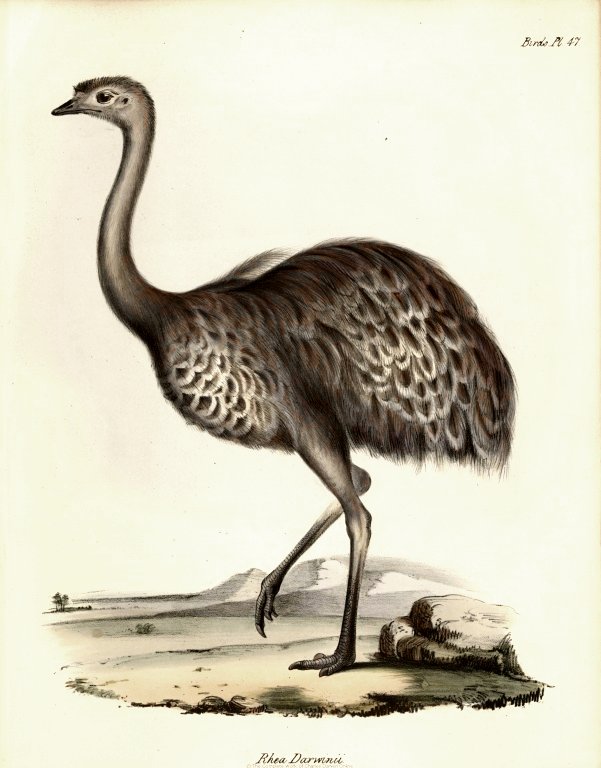 John Gould's illustration of Darwin's rhea was published in 1841. The existence of two rhea species with overlapping ranges influenced Darwin. Page ii contains quotations by William Whewell and Francis Bacon on the theology of natural laws,[107] harmonising science and religion in accordance with Isaac Newton's belief in a rational God who established a law-abiding cosmos.[108] In the second edition, Darwin added an epigraph from Joseph Butler affirming that God could work through scientific laws as much as through miracles, in a nod to the religious concerns of his oldest friends.[84] The Introduction establishes Darwin's credentials as a naturalist and author,[109] then refers to John Herschel's letter suggesting that the origin of species "would be found to be a natural in contradistinction to a miraculous process":[110] WHEN on board HMS Beagle, as naturalist, I was much struck with certain facts in the distribution of the inhabitants of South America, and in the geological relations of the present to the past inhabitants of that continent. These facts seemed to me to throw some light on the origin of species—that mystery of mysteries, as it has been called by one of our greatest philosophers.[111] Darwin refers specifically to the distribution of the species rheas, and to that of the Galápagos tortoises and mockingbirds. He mentions his years of work on his theory, and the arrival of Wallace at the same conclusion, which led him to "publish this Abstract" of his incomplete work. He outlines his ideas, and sets out the essence of his theory: As many more individuals of each species are born than can possibly survive; and as, consequently, there is a frequently recurring struggle for existence, it follows that any being, if it vary however slightly in any manner profitable to itself, under the complex and sometimes varying conditions of life, will have a better chance of surviving, and thus be naturally selected. From the strong principle of inheritance, any selected variety will tend to propagate its new and modified form.[112] Starting with the third edition, Darwin prefaced the introduction with a sketch of the historical development of evolutionary ideas.[113] In that sketch he acknowledged that Patrick Matthew had, unknown to Wallace or himself, anticipated the concept of natural selection in an appendix to a book published in 1831;[114] in the fourth edition he mentioned that William Charles Wells had done so as early as 1813.[115] Variation under domestication and under nature Chapter I covers animal husbandry and plant breeding, going back to ancient Egypt. Darwin discusses contemporary opinions on the origins of different breeds under cultivation to argue that many have been produced from common ancestors by selective breeding.[116] As an illustration of artificial selection, he describes fancy pigeon breeding,[117] noting that "[t]he diversity of the breeds is something astonishing", yet all were descended from one species of rock pigeon.[118] Darwin saw two distinct kinds of variation: (1) rare abrupt changes he called "sports" or "monstrosities" (example: Ancon sheep with short legs), and (2) ubiquitous small differences (example: slightly shorter or longer bill of pigeons).[119] Both types of hereditary changes can be used by breeders. However, for Darwin the small changes were most important in evolution. In this chapter Darwin expresses his erroneous belief that environmental change is necessary to generate variation.[120] In Chapter II, Darwin specifies that the distinction between species and varieties is arbitrary, with experts disagreeing and changing their decisions when new forms were found. He concludes that "a well-marked variety may be justly called an incipient species" and that "species are only strongly marked and permanent varieties".[121] He argues for the ubiquity of variation in nature.[122] Historians have noted that naturalists had long been aware that the individuals of a species differed from one another, but had generally considered such variations to be limited and unimportant deviations from the archetype of each species, that archetype being a fixed ideal in the mind of God. Darwin and Wallace made variation among individuals of the same species central to understanding the natural world.[117] Struggle for existence, natural selection, and divergence In Chapter III, Darwin asks how varieties "which I have called incipient species" become distinct species, and in answer introduces the key concept he calls "natural selection";[123] in the fifth edition he adds, "But the expression often used by Mr. Herbert Spencer, of the Survival of the Fittest, is more accurate, and is sometimes equally convenient."[124] Owing to this struggle for life, any variation, however slight and from whatever cause proceeding, if it be in any degree profitable to an individual of any species, in its infinitely complex relations to other organic beings and to external nature, will tend to the preservation of that individual, and will generally be inherited by its offspring ... I have called this principle, by which each slight variation, if useful, is preserved, by the term of Natural Selection, in order to mark its relation to man's power of selection.[123] He notes that both A. P. de Candolle and Charles Lyell had stated that all organisms are exposed to severe competition. Darwin emphasizes that he used the phrase "struggle for existence" in "a large and metaphorical sense, including dependence of one being on another"; he gives examples ranging from plants struggling against drought to plants competing for birds to eat their fruit and disseminate their seeds. He describes the struggle resulting from population growth: "It is the doctrine of Malthus applied with manifold force to the whole animal and vegetable kingdoms." He discusses checks to such increase including complex ecological interdependencies, and notes that competition is most severe between closely related forms "which fill nearly the same place in the economy of nature".[125] Chapter IV details natural selection under the "infinitely complex and close-fitting ... mutual relations of all organic beings to each other and to their physical conditions of life".[126] Darwin takes as an example a country where a change in conditions led to extinction of some species, immigration of others and, where suitable variations occurred, descendants of some species became adapted to new conditions. He remarks that the artificial selection practised by animal breeders frequently produced sharp divergence in character between breeds, and suggests that natural selection might do the same, saying: But how, it may be asked, can any analogous principle apply in nature? I believe it can and does apply most efficiently, from the simple circumstance that the more diversified the descendants from any one species become in structure, constitution, and habits, by so much will they be better enabled to seize on many and widely diversified places in the polity of nature, and so be enabled to increase in numbers.[127] Historians have remarked that here Darwin anticipated the modern concept of an ecological niche.[128] He did not suggest that every favourable variation must be selected, nor that the favoured animals were better or higher, but merely more adapted to their surroundings. 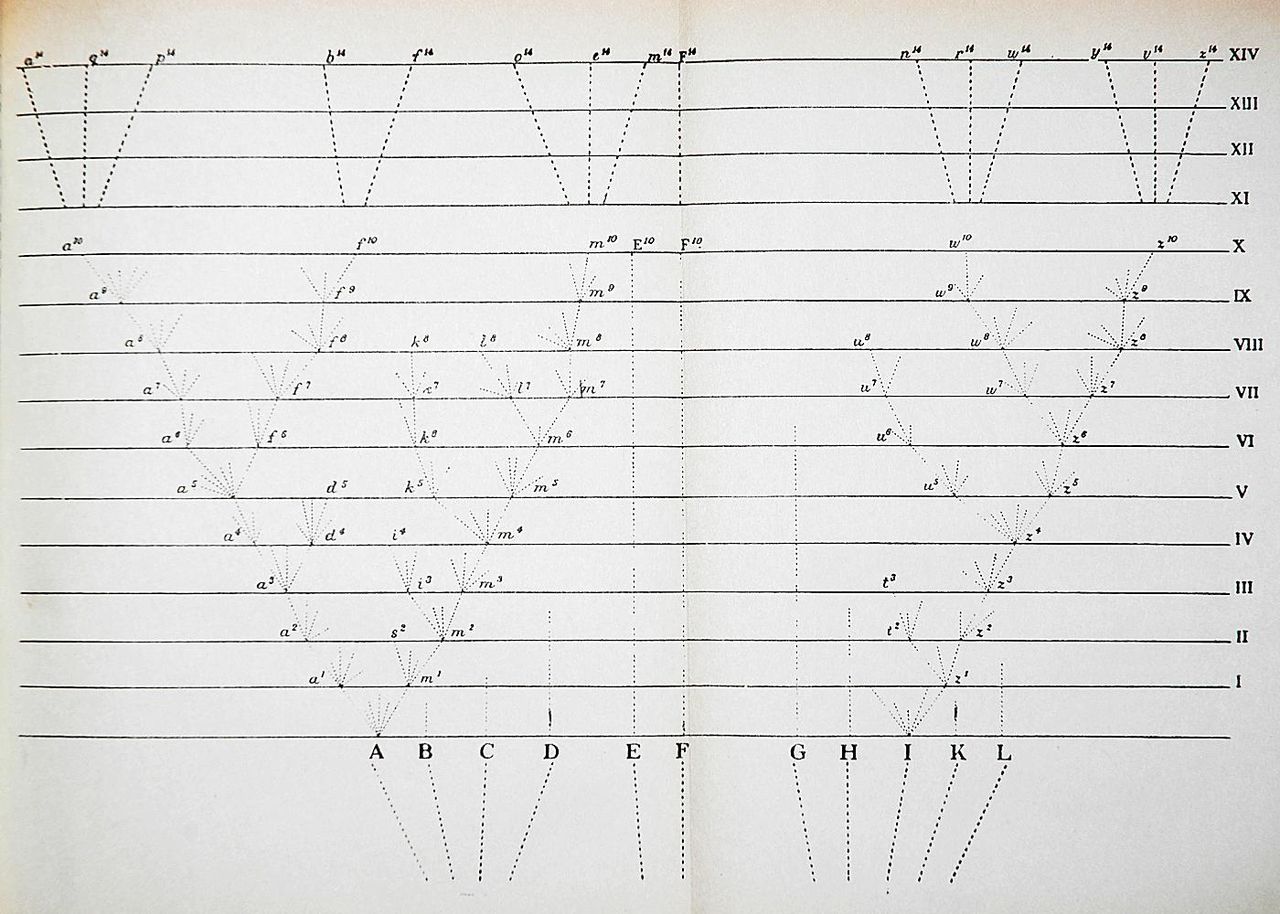 This tree diagram, used to show the divergence of species, is the only illustration in the Origin of Species. Darwin proposes sexual selection, driven by competition between males for mates, to explain sexually dimorphic features such as lion manes, deer antlers, peacock tails, bird songs, and the bright plumage of some male birds.[129] He analysed sexual selection more fully in The Descent of Man, and Selection in Relation to Sex (1871). Natural selection was expected to work very slowly in forming new species, but given the effectiveness of artificial selection, he could "see no limit to the amount of change, to the beauty and infinite complexity of the coadaptations between all organic beings, one with another and with their physical conditions of life, which may be effected in the long course of time by nature's power of selection". Using a tree diagram and calculations, he indicates the "divergence of character" from original species into new species and genera. He describes branches falling off as extinction occurred, while new branches formed in "the great Tree of life ... with its ever branching and beautiful ramifications".[130] Variation and heredity In Darwin's time there was no agreed-upon model of heredity;[131] in Chapter I Darwin admitted, "The laws governing inheritance are quite unknown."[132] He accepted a version of the inheritance of acquired characteristics (which after Darwin's death came to be called Lamarckism), and Chapter V discusses what he called the effects of use and disuse; he wrote that he thought "there can be little doubt that use in our domestic animals strengthens and enlarges certain parts, and disuse diminishes them; and that such modifications are inherited", and that this also applied in nature.[133] Darwin stated that some changes that were commonly attributed to use and disuse, such as the loss of functional wings in some island-dwelling insects, might be produced by natural selection. In later editions of Origin, Darwin expanded the role attributed to the inheritance of acquired characteristics. Darwin also admitted ignorance of the source of inheritable variations, but speculated they might be produced by environmental factors.[134][135] However, one thing was clear: whatever the exact nature and causes of new variations, Darwin knew from observation and experiment that breeders were able to select such variations and produce huge differences in many generations of selection.[119] The observation that selection works in domestic animals is not destroyed by lack of understanding of the underlying hereditary mechanism. Breeding of animals and plants showed related varieties varying in similar ways, or tending to revert to an ancestral form, and similar patterns of variation in distinct species were explained by Darwin as demonstrating common descent. He recounted how Lord Morton's mare apparently demonstrated telegony, offspring inheriting characteristics of a previous mate of the female parent, and accepted this process as increasing the variation available for natural selection.[136][137] More detail was given in Darwin's 1868 book on The Variation of Animals and Plants Under Domestication, which tried to explain heredity through his hypothesis of pangenesis. Although Darwin had privately questioned blending inheritance, he struggled with the theoretical difficulty that novel individual variations would tend to blend into a population. However, inherited variation could be seen,[138] and Darwin's concept of selection working on a population with a range of small variations was workable.[139] It was not until the modern evolutionary synthesis in the 1930s and 1940s that a model of heredity became completely integrated with a model of variation.[140] This modern evolutionary synthesis had been dubbed Neo Darwinian Evolution because it encompasses Charles Darwin's theories of evolution with Gregor Mendel's theories of genetic inheritance.[141] Difficulties for the theory Chapter VI begins by saying the next three chapters will address possible objections to the theory, the first being that often no intermediate forms between closely related species are found, though the theory implies such forms must have existed. As Darwin noted, "Firstly, why, if species have descended from other species by insensibly fine gradations, do we not everywhere see innumerable transitional forms? Why is not all nature in confusion, instead of the species being, as we see them, well defined?"[142] Darwin attributed this to the competition between different forms, combined with the small number of individuals of intermediate forms, often leading to extinction of such forms.[143] Another difficulty, related to the first one, is the absence or rarity of transitional varieties in time. Darwin commented that by the theory of natural selection "innumerable transitional forms must have existed," and wondered "why do we not find them embedded in countless numbers in the crust of the earth?"[144] (For further discussion of these difficulties, see Speciation#Darwin's dilemma: Why do species exist? and Bernstein et al.[145] and Michod.[146]) The chapter then deals with whether natural selection could produce complex specialised structures, and the behaviours to use them, when it would be difficult to imagine how intermediate forms could be functional. Darwin said: Secondly, is it possible that an animal having, for instance, the structure and habits of a bat, could have been formed by the modification of some animal with wholly different habits? Can we believe that natural selection could produce, on the one hand, organs of trifling importance, such as the tail of a giraffe, which serves as a fly-flapper, and, on the other hand, organs of such wonderful structure, as the eye, of which we hardly as yet fully understand the inimitable perfection?[147] His answer was that in many cases animals exist with intermediate structures that are functional. He presented flying squirrels, and flying lemurs as examples of how bats might have evolved from non-flying ancestors.[148] He discussed various simple eyes found in invertebrates, starting with nothing more than an optic nerve coated with pigment, as examples of how the vertebrate eye could have evolved. Darwin concludes: "If it could be demonstrated that any complex organ existed, which could not possibly have been formed by numerous, successive, slight modifications, my theory would absolutely break down. But I can find out no such case."[149] In a section on "organs of little apparent importance", Darwin discusses the difficulty of explaining various seemingly trivial traits with no evident adaptive function, and outlines some possibilities such as correlation with useful features. He accepts that we "are profoundly ignorant of the causes producing slight and unimportant variations" which distinguish domesticated breeds of animals,[150] and human races. He suggests that sexual selection might explain these variations:[151][152] I might have adduced for this same purpose the differences between the races of man, which are so strongly marked; I may add that some little light can apparently be thrown on the origin of these differences, chiefly through sexual selection of a particular kind, but without here entering on copious details my reasoning would appear frivolous.[153] Chapter VII (of the first edition) addresses the evolution of instincts. His examples included two he had investigated experimentally: slave-making ants and the construction of hexagonal cells by honey bees. Darwin noted that some species of slave-making ants were more dependent on slaves than others, and he observed that many ant species will collect and store the pupae of other species as food. He thought it reasonable that species with an extreme dependency on slave workers had evolved in incremental steps. He suggested that bees that make hexagonal cells evolved in steps from bees that made round cells, under pressure from natural selection to economise wax. Darwin concluded: Finally, it may not be a logical deduction, but to my imagination it is far more satisfactory to look at such instincts as the young cuckoo ejecting its foster-brothers, —ants making slaves, —the larvæ of ichneumonidæ feeding within the live bodies of caterpillars, —not as specially endowed or created instincts, but as small consequences of one general law, leading to the advancement of all organic beings, namely, multiply, vary, let the strongest live and the weakest die.[154] Chapter VIII addresses the idea that species had special characteristics that prevented hybrids from being fertile in order to preserve separately created species. Darwin said that, far from being constant, the difficulty in producing hybrids of related species, and the viability and fertility of the hybrids, varied greatly, especially among plants. Sometimes what were widely considered to be separate species produced fertile hybrid offspring freely, and in other cases what were considered to be mere varieties of the same species could only be crossed with difficulty. Darwin concluded: "Finally, then, the facts briefly given in this chapter do not seem to me opposed to, but even rather to support the view, that there is no fundamental distinction between species and varieties."[155] In the sixth edition Darwin inserted a new chapter VII (renumbering the subsequent chapters) to respond to criticisms of earlier editions, including the objection that many features of organisms were not adaptive and could not have been produced by natural selection. He said some such features could have been by-products of adaptive changes to other features, and that often features seemed non-adaptive because their function was unknown, as shown by his book on Fertilisation of Orchids that explained how their elaborate structures facilitated pollination by insects. Much of the chapter responds to George Jackson Mivart's criticisms, including his claim that features such as baleen filters in whales, flatfish with both eyes on one side and the camouflage of stick insects could not have evolved through natural selection because intermediate stages would not have been adaptive. Darwin proposed scenarios for the incremental evolution of each feature.[156] Geological record Chapter IX deals with the fact that the geological record appears to show forms of life suddenly arising, without the innumerable transitional fossils expected from gradual changes. Darwin borrowed Charles Lyell's argument in Principles of Geology that the record is extremely imperfect as fossilisation is a very rare occurrence, spread over vast periods of time; since few areas had been geologically explored, there could only be fragmentary knowledge of geological formations, and fossil collections were very poor. Evolved local varieties which migrated into a wider area would seem to be the sudden appearance of a new species. Darwin did not expect to be able to reconstruct evolutionary history, but continuing discoveries gave him well-founded hope that new finds would occasionally reveal transitional forms.[157][158] To show that there had been enough time for natural selection to work slowly, he cited the example of The Weald as discussed in Principles of Geology together with other observations from Hugh Miller, James Smith of Jordanhill and Andrew Ramsay. Combining this with an estimate of recent rates of sedimentation and erosion, Darwin calculated that erosion of The Weald had taken around 300 million years.[159] The initial appearance of entire groups of well-developed organisms in the oldest fossil-bearing layers, now known as the Cambrian explosion, posed a problem. Darwin had no doubt that earlier seas had swarmed with living creatures, but stated that he had no satisfactory explanation for the lack of fossils.[160] Fossil evidence of pre-Cambrian life has since been found, extending the history of life back for billions of years.[161] Chapter X examines whether patterns in the fossil record are better explained by common descent and branching evolution through natural selection, than by the individual creation of fixed species. Darwin expected species to change slowly, but not at the same rate – some organisms such as Lingula were unchanged since the earliest fossils. The pace of natural selection would depend on variability and change in the environment.[162] This distanced his theory from Lamarckian laws of inevitable progress.[157] It has been argued that this anticipated the punctuated equilibrium hypothesis,[158][163] but other scholars have preferred to emphasise Darwin's commitment to gradualism.[164] He cited Richard Owen's findings that the earliest members of a class were a few simple and generalised species with characteristics intermediate between modern forms, and were followed by increasingly diverse and specialised forms, matching the branching of common descent from an ancestor.[157] Patterns of extinction matched his theory, with related groups of species having a continued existence until extinction, then not reappearing. Recently extinct species were more similar to living species than those from earlier eras, and as he had seen in South America, and William Clift had shown in Australia, fossils from recent geological periods resembled species still living in the same area.[162] Geographic distribution Chapter XI deals with evidence from biogeography, starting with the observation that differences in flora and fauna from separate regions cannot be explained by environmental differences alone; South America, Africa, and Australia all have regions with similar climates at similar latitudes, but those regions have very different plants and animals. The species found in one area of a continent are more closely allied with species found in other regions of that same continent than to species found on other continents. Darwin noted that barriers to migration played an important role in the differences between the species of different regions. The coastal sea life of the Atlantic and Pacific sides of Central America had almost no species in common even though the Isthmus of Panama was only a few miles wide. His explanation was a combination of migration and descent with modification. He went on to say: "On this principle of inheritance with modification, we can understand how it is that sections of genera, whole genera, and even families are confined to the same areas, as is so commonly and notoriously the case."[165] Darwin explained how a volcanic island formed a few hundred miles from a continent might be colonised by a few species from that continent. These species would become modified over time, but would still be related to species found on the continent, and Darwin observed that this was a common pattern. Darwin discussed ways that species could be dispersed across oceans to colonise islands, many of which he had investigated experimentally.[166] Chapter XII continues the discussion of biogeography. After a brief discussion of freshwater species, it returns to oceanic islands and their peculiarities; for example on some islands roles played by mammals on continents were played by other animals such as flightless birds or reptiles. The summary of both chapters says: ... I think all the grand leading facts of geographical distribution are explicable on the theory of migration (generally of the more dominant forms of life), together with subsequent modification and the multiplication of new forms. We can thus understand the high importance of barriers, whether of land or water, which separate our several zoological and botanical provinces. We can thus understand the localisation of sub-genera, genera, and families; and how it is that under different latitudes, for instance in South America, the inhabitants of the plains and mountains, of the forests, marshes, and deserts, are in so mysterious a manner linked together by affinity, and are likewise linked to the extinct beings which formerly inhabited the same continent ... On these same principles, we can understand, as I have endeavoured to show, why oceanic islands should have few inhabitants, but of these a great number should be endemic or peculiar; ...[167] Classification, morphology, embryology, rudimentary organs Chapter XIII starts by observing that classification depends on species being grouped together in a Taxonomy, a multilevel system of groups and sub-groups based on varying degrees of resemblance. After discussing classification issues, Darwin concludes: All the foregoing rules and aids and difficulties in classification are explained, if I do not greatly deceive myself, on the view that the natural system is founded on descent with modification; that the characters which naturalists consider as showing true affinity between any two or more species, are those which have been inherited from a common parent, and, in so far, all true classification is genealogical; that community of descent is the hidden bond which naturalists have been unconsciously seeking, ...[168] Darwin discusses morphology, including the importance of homologous structures. He says, "What can be more curious than that the hand of a man, formed for grasping, that of a mole for digging, the leg of the horse, the paddle of the porpoise, and the wing of the bat, should all be constructed on the same pattern, and should include the same bones, in the same relative positions?" This made no sense under doctrines of independent creation of species, as even Richard Owen had admitted, but the "explanation is manifest on the theory of the natural selection of successive slight modifications" showing common descent.[169] He notes that animals of the same class often have extremely similar embryos. Darwin discusses rudimentary organs, such as the wings of flightless birds and the rudiments of pelvis and leg bones found in some snakes. He remarks that some rudimentary organs, such as teeth in baleen whales, are found only in embryonic stages.[170] These factors also supported his theory of descent with modification.[31] Concluding remarks The final chapter, "Recapitulation and Conclusion", reviews points from earlier chapters, and Darwin concludes by hoping that his theory might produce revolutionary changes in many fields of natural history.[171] He suggests that psychology will be put on a new foundation and implies the relevance of his theory to the first appearance of humanity with the sentence that "Light will be thrown on the origin of man and his history."[31][172] Darwin ends with a passage that became well known and much quoted: It is interesting to contemplate an entangled bank, clothed with many plants of many kinds, with birds singing on the bushes, with various insects flitting about, and with worms crawling through the damp earth, and to reflect that these elaborately constructed forms, so different from each other, and dependent on each other in so complex a manner, have all been produced by laws acting around us ... Thus, from the war of nature, from famine and death, the most exalted object which we are capable of conceiving, namely, the production of the higher animals, directly follows. There is grandeur in this view of life, with its several powers, having been originally breathed into a few forms or into one; and that, whilst this planet has gone cycling on according to the fixed law of gravity, from so simple a beginning endless forms most beautiful and most wonderful have been, and are being, evolved.[173] Darwin added the phrase "by the Creator" from the 1860 second edition onwards, so that the ultimate sentence begins "There is grandeur in this view of life, with its several powers, having been originally breathed by the Creator into a few forms or into one".[174] |
コンテンツ タイトルページと序文  ジョン・グールドが描いたダーウィンのレアのイラストは1841年に出版された。生息域が重複する2種のレアの存在は、ダーウィンに影響を与えた。 第2版では、ダーウィンはジョセフ・バトラーの碑文を追加し、神は奇跡と同様に科学的法則を通して働くことができると断言した。 [84]「はじめに」では、博物学者であり著者であるダーウィンの信憑性を確立し[109]、次に種の起源が「奇跡的な過程とは対照的に自然なものである ことが判明するだろう」と示唆したジョン・ハーシェルの手紙に言及している[110]。 HMSビーグル号に博物学者として乗船したとき、私は南アメリカ大陸の住民の分布や、現在の住民と過去の住民との地質学的な関係において、ある事実に強い衝撃を受けた。これらの事実は、種の起源に何らかの光を投げかけているように私には思えた。 ダーウィンは特にレア種の分布、ガラパゴスゾウガメとモッキンバードの分布について言及している。ダーウィンは、長年にわたる自説への取り組みと、ウォー レスが同じ結論に達したこと、そして未完成であった自説の「この抄録を出版する」ことになったことに触れている。彼は自分の考えを概説し、理論のエッセン スを述べている: それぞれの種の個体は、生き残る可能性のある個体よりも多く生まれ、その結果、生存のための闘争が頻繁に繰り返されるのであるから、生命の複雑で時に変化 する条件のもとで、自分にとって有益な方法で少しでも変化すれば、どのような存在であれ、生き残る可能性が高くなり、自然に選択されることになる。遺伝の 強力な原理から、選択された品種は、その新しい修正された形態を伝播する傾向がある。 第3版から、ダーウィンは序論で進化論の思想の歴史的発展のスケッチを前置きするようになった[113]。そのスケッチの中で彼は、パトリック・マシュー がウォレスにも彼自身にも知られていなかったが、1831年に出版された本の付録で自然淘汰の概念を予期していたことを認めた[114]。 家畜化と自然下での変異 第1章は古代エジプトにさかのぼり、動物の飼育と植物の品種改良を扱っている。ダーウィンは、選択的育種によって共通の祖先から多くの品種が生み出された ことを主張するために、栽培されているさまざまな品種の起源に関する現代の意見を論じている[116]。人為的選択の例として、彼はファンシーなハトの育 種について述べており[117]、「品種の多様性は驚くべきものである」と指摘しながらも、すべての品種が1種のロックバトの子孫であると述べている [118]。 [118]ダーウィンは2つの異なる種類の変化を見た:(1)彼が「スポーツ」または「怪物」と呼んだまれな突然の変化(例:短い脚を持つアンコンヒツ ジ)、(2)どこにでもある小さな違い(例:ハトのわずかに短いまたは長い嘴)。しかし、ダーウィンにとっては、小さな変化が進化において最も重要であっ た。この章でダーウィンは、環境変化が変異を生み出すために必要であるという彼の誤った信念を表明している[120]。 第二章では、ダーウィンは、種と品種の区別は恣意的なものであり、新しい形が発見されたときには専門家の意見が食い違い、決定が変わるものであると述べて いる。ダーウィンは、自然界における変異の偏在性を主張する。歴史家は、博物学者は長い間、種の個体が互いに異なることを認識していたが、一般的にそのよ うな変異はそれぞれの種の原型からの限定的で重要でない逸脱であり、その原型は神の心の中にある固定された理想であるとみなしていたと指摘する [122]。ダーウィンとウォーレスは、同じ種の個体間の変異を自然界を理解するための中心に据えた[117]。 生存競争、自然選択、分岐 第III章において、ダーウィンは「私が初期種と呼んできた」品種がどのようにして別個の種になるのかを問い、その答えとして彼が「自然淘汰」と呼ぶ重要な概念を導入する[123]。 この生命のための闘争のおかげで、いかなる種の個体にとっても、それが他の有機的存在や外的自然との無限に複雑な関係において、いくらかでも有益であるな らば、どのような変異であっても、それがいかにわずかであっても、またどのような原因から生じたものであっても、その個体の保存につながり、一般にその子 孫に受け継がれることになる......。私は、わずかな変異が有用であれば保存されるというこの原理を、人間の淘汰力との関係を示すために、自然淘汰と いう言葉で呼んだ。 ダーウィンは、A.P.ド・カンドールとチャールズ・ライエルが、すべての生物は厳しい競争にさらされていると述べていたことを指摘している。ダーウィン は、「生存のための闘争」という言葉を「ある存在が他の存在に依存することを含む、大規模で比喩的な意味」で使ったことを強調し、干ばつと闘う植物から、 果実を食べ種子を広めるために鳥を奪い合う植物まで、さまざまな例を挙げている。彼は人口増加から生じる闘争についてこう述べている: 「これはマルサスの学説を動物界と植物界全体に様々な力をもって適用したものである」。彼は、複雑な生態学的相互依存関係を含む、そのような増加に対する 歯止めについて論じ、「自然の経済においてほぼ同じ位置を占める」密接に関連した形態間の競争が最も厳しいことを指摘する[125]。 ダーウィンは、条件の変化によっていくつかの種が絶滅し、他の種が移住し、適切な変異が生じた場合、いくつかの種の子孫が新しい条件に適応するようになっ た国を例にとっている。彼は、動物の品種改良者が行っている人為的淘汰が、品種間の性格の鋭い分岐をしばしば生み出していることを指摘し、自然淘汰も同じ ことをするのではないかと示唆している: しかし、自然界に類似の原理が適用できるのだろうか?私は、一つの種からの子孫が構造、体質、習性においてより多様化すればするほど、自然界の政治におい て多くの、そして広く多様化した場所をつかむことがよりよく可能になり、その結果、数を増やすことが可能になるという単純な状況から、それは最も効率的に 適用することができ、実際に適用されていると信じている[127]。 歴史家たちは、ダーウィンがここで現代の生態学的ニッチの概念を先取りしたことを指摘している[128]。ダーウィンは、好ましい変異がすべて選択されな ければならないとか、好ましい動物がより優れているとか、より高等であるとかではなく、単に周囲の環境により適応していると示唆したのである。  種の分岐を示すために使われたこの樹形図は、『種の起源』の中で唯一の図解である。 ダーウィンは、ライオンのたてがみ、シカの角、クジャクの尾、鳥のさえずり、いくつかの鳥のオスの鮮やかな羽毛など、性的に二型である特徴を説明するため に、交尾相手をめぐるオス同士の競争によって引き起こされる性淘汰を提唱している[129]。自然淘汰は新しい種を形成するのに非常にゆっくりと働くと予 想されていたが、人為淘汰の有効性を考えると、彼は「自然の淘汰の力によって長い時間のうちにもたらされるであろう、すべての有機的存在の間の、互いに、 そして彼らの生活の物理的条件との間の共適応の変化の量、美しさ、そして無限の複雑さには限界がない」と考えた。彼は樹形図と計算を用いて、原種から新し い種や属への「性質の分岐」を示している。彼は、絶滅が起こるにつれて枝が落ちる一方で、新しい枝が「絶えず枝分かれし、美しい枝分かれをしてい る......偉大な生命の木」に形成されたことを描写している[130]。 変異と遺伝 ダーウィンの時代には、遺伝について合意されたモデルはなかった。 「ダーウィンは第1章で「遺伝を支配する法則はまったく未知である」と認めており[131]、後天的特徴の遺伝(ダーウィンの死後、ラマルク主義と呼ばれ るようになった)を受け入れ、第5章では使用と不使用の影響と呼ばれるものについて論じている。 [ダーウィンは、一般的に使用と不使用に起因するとされるいくつかの変化、例えば島に住む昆虫の翅の機能喪失などは、自然淘汰によって生じるかもしれない と述べた。ダーウィンは『起原』の後の版で、後天的に獲得された特徴の遺伝が果たす役割を拡大した。ダーウィンはまた、遺伝可能な変異の原因について無知 であることを認めたが、環境要因によって生み出されるのではないかと推測した[134][135]。しかし、1つのことは明らかであった。新しい変異の正 確な性質と原因が何であれ、ダーウィンは観察と実験から、繁殖者がそのような変異を選択することができ、何世代にもわたる淘汰の中で大きな違いを生み出す ことができることを知っていた[119]。家畜において淘汰が機能するという観察は、根底にある遺伝メカニズムが理解されていないからといって崩れるもの ではない。 動物や植物の品種改良では、近縁の品種が似たような方法で変化したり、祖先の形に回帰する傾向が見られた。ダーウィンは、モートン卿の雌馬が明らかにテレ ゴニーを示し、子孫が雌親の以前の交尾相手の特徴を受け継いだことを語り、このプロセスを自然選択に利用可能な変異を増加させるものとして受け入れた [136][137]。 さらに詳しいことは、1868年にダーウィンが出版した『The Variation of Animals and Plants Under Domestication(家畜化された動植物の変異)』に書かれており、パンゲネシスの仮説によって遺伝を説明しようとしていた。ダーウィンは内心で は混合遺伝に疑問を抱いていたものの、新奇な個体変異は集団に溶け込む傾向があるという理論的な難題に苦慮していた。しかし、受け継がれた変異は見ること ができ[138]、ダーウィンの小さな変異の範囲を持つ集団に働く淘汰の概念は実行可能であった[139]。遺伝のモデルが変異のモデルと完全に統合され るようになったのは、1930年代と1940年代の近代進化論的総合まで待たなければならなかった[140]。この近代進化論的総合は、チャールズ・ダー ウィンの進化論とグレゴール・メンデルの遺伝の理論を包含することから、ネオ・ダーウィン進化論と呼ばれていた[141]。 理論の難点 第VI章は、次の3つの章ではこの理論に対する反論の可能性を取り上げると述べて始まる。その第一は、この理論では近縁種の間に中間形態が存在したはずで あるにもかかわらず、しばしばそのような形態が発見されないということである。ダーウィンは、「第一に、もし種が他の種から目に見えないほど微細な段階を 経て下降してきたのだとしたら、なぜわれわれはいたるところで無数の過渡的形態を目にすることができないのだろうか。ダーウィンはこれを、異なる形態間の 競争と、中間的な形態の個体数の少なさとが相まって、しばしばそのような形態の絶滅につながるためであるとした[143]。 もう一つの難点は、最初の難点と関連しているが、時間的に過渡的な品種が存在しないか稀であることである。ダーウィンは、自然淘汰の理論によって「無数の 過渡的形態が存在したはずである」とコメントし、「なぜ地殻の中に無数に埋め込まれているのが見つからないのだろうか」と考えた[144](これらの困難 についてのさらなる議論は、「種分化#ダーウィンのジレンマ:なぜ種は存在するのか」、バーンスタインら[145]、ミショッド[146]を参照)。 この章では次に、中間的な形態がどのように機能しうるかを想像することが困難な場合に、自然淘汰が複雑で特殊化した構造とそれを利用する行動を生み出すことができるかどうかを扱う。ダーウィンは言う: 第二に、例えばコウモリのような構造と習性を持つ動物が、全く異なる習性を持つ動物の変化によって形成された可能性はあるのだろうか?一方では、キリンの 尾のようにハエたたきの役割を果たすような、ささいな重要性をもつ器官を、他方では、眼球のように素晴らしい構造をもつ器官を、その比類ない完全性をまだ 十分に理解していない私たちが生み出すことができると、私たちは信じることができるだろうか[147]」。 彼の答えは、多くの場合、動物は機能的な中間構造をもって存在するというものであった。また、脊椎動物の眼がどのように進化したかを示す例として、無脊椎 動物に見られる、色素で覆われた視神経しかない単純な眼を取り上げた[148]。ダーウィンはこう結んでいる: 「もし、数多くの、連続した、わずかな変化によって形成されたとは考えられないような複雑な器官が存在することが証明されれば、私の理論は絶対に破綻する だろう。しかし、私はそのようなケースを見つけることができない」[149]。 ダーウィンは、「ほとんど重要でないと思われる器官」のセクションで、明らかな適応的機能を持たない様々な一見些細な形質を説明することの難しさを論じ、 有用な特徴との相関関係などのいくつかの可能性を概説している。彼は、家畜化された動物の品種や[150]、人間の人種を区別する「わずかで重要でない変 異を生み出す原因について、我々は深く無知である」ことを認めている。彼は、性淘汰がこれらの変異を説明するかもしれないと示唆している[151] [152]。 私はこれと同じ目的のために、非常に顕著な人間の種族間の差異を引き合いに出したかもしれない。これらの差異の起源について、主に特定の種類の性淘汰に よって、明らかに若干の光を投げかけることができることを付け加えてもよいが、ここで大量の詳細に立ち入らなければ、私の推論は軽薄に見えるだろう [153]。 初版の)第VII章は本能の進化を取り上げている。彼の例には、彼が実験的に調査した2つのものが含まれていた:奴隷を作るアリとミツバチによる六角形の 細胞の構築。ダーウィンは、奴隷を作るアリの中には他の種よりも奴隷に依存する種がいることに注目し、多くのアリの種が他の種のサナギを集めて食料として 蓄えることを観察した。ダーウィンは、奴隷労働者への依存度が極端に高い種は、段階的に進化してきたと考えた。彼は、六角形の細胞を作るミツバチは、丸い 細胞を作るミツバチから段階的に進化してきたと示唆した。ダーウィンはこう結論づけた: 最後に、論理的な推論ではないかもしれないが、私の想像力では、若いカッコウが育ての親を追い出したり、アリが奴隷を作ったり、イモムシの幼虫がイモムシ の生きた体内で餌を食べたりするような本能を、特別に与えられた本能や創造された本能としてではなく、すべての有機的生物の進歩につながる、ある一般的な 法則の小さな結果として見るほうがはるかに納得がいく。 第8章では、種には特別な特徴があり、別々に創造された種を保存するために雑種が繁殖することを妨げているという考えを取り上げている。ダーウィンは、近 縁種の雑種を作り出す難しさや、雑種の生存可能性や繁殖力は、一定しているどころか、特に植物の間で大きく異なると述べている。別個の種と広く考えられて いたものが、繁殖力のある雑種を自由に生み出すこともあれば、同じ種の単なる品種と考えられていたものが、困難な交配しかできない場合もあった。ダーウィ ンはこう結論づけた: 「最後に、この章で簡単に述べた事実は、種と品種の間に基本的な区別はないという見解に反対するものではなく、むしろ支持するものであるとさえ思われる」 [155]。 第6版では、ダーウィンは、生物の多くの特徴は適応的ではなく、自然淘汰によって生み出されることはありえないという反論を含む、それ以前の版に対する批 判に答えるために、新しい第7章を挿入した(それ以降の章の番号を変更)。また、ランの受精に関する著書で、ランの精巧な構造が昆虫による受粉を容易にす ることを説明したように、その機能が不明であるために、非適応的に見えることがしばしばあると述べた。この章の大部分は、ジョージ・ジャクソン・ミバート の批判に答えるもので、クジラのヒゲフィルターや、両目が片側にあるヒラメ、ナナフシのカモフラージュなどの特徴は、中間段階が適応的でなかったため、自 然淘汰によって進化しなかったという彼の主張を含む。ダーウィンは、それぞれの特徴が段階的に進化するシナリオを提案した[156]。 地質学的記録 第9章では、地質学的記録が、漸進的な変化から予想される無数の過渡的な化石を伴わずに、突然発生した生命の形態を示しているように見えるという事実を扱 う。ダーウィンは、『地質学原理』のチャールズ・ライエル(Charles Lyell)の主張を借用し、化石化は非常にまれな出来事であり、膨大な期間にまたがっているため、記録は極めて不完全であるとした。地質学的な調査が行 われた地域がほとんどなかったため、地層に関する知識は断片的なものでしかなく、化石のコレクションも非常に乏しかったのである。ダーウィンは進化の歴史 を再構築できるとは思っていなかったが、発見が続くことで、新たな発見が時折過渡的な形態を明らかにするのではないかという根拠のある期待を抱くように なった[157][158]。自然淘汰がゆっくりと働くのに十分な時間があったことを示すために、彼は『地質学の原理』で論じられているウィールドの例 と、ヒュー・ミラー、ジョーダンヒルのジェームズ・スミス、アンドリュー・ラムゼイの他の観察を引用した。これを最近の堆積と浸食の速度の見積もりと組み 合わせて、ダーウィンはウィールドの浸食におよそ3億年かかったと計算した[159]。現在カンブリア紀の爆発として知られている、化石を含む最も古い層 で、よく発達した生物のグループ全体が最初に出現したことは、問題を提起した。ダーウィンは、それ以前の海が生物でうまっていたことは疑っていなかった が、化石がないことについては納得のいく説明ができなかったと述べている[160]。その後、カンブリア紀以前の生命の化石証拠が発見され、生命の歴史は 何十億年もさかのぼることになった[161]。 第X章は、化石の記録におけるパターンが、固定種の個別的な創造によってよりも、自然淘汰による共通降下と枝分かれ進化によってよりよく説明されるかどう かを検証している。ダーウィンは、種はゆっくりと変化すると予想していたが、同じ速度で変化するわけではない。自然淘汰のペースは環境の変動性と変化に依 存する[162]。このことは、必然的な進歩というラマルクの法則からダーウィンの理論を遠ざけるものであった[157]。 [ダーウィンはリチャード・オーウェンの発見を引用し、ある種の最も初期のメンバーは、現代の形態の中間的な特徴を持つ少数の単純で一般化された種であ り、その後、ますます多様化し特殊化した形態が続き、祖先からの共通子孫の分岐と一致した。また、彼が南米で見たように、またウィリアム・クリフトがオー ストラリアで示したように、最近の地質時代の化石は、現在も同じ地域に生息する種と類似していた[162]。 地理的分布 第XI章は生物地理学的な証拠を扱い、別々の地域の動植物の違いは環境の違いだけでは説明できないという観察から始まる。ある大陸のある地域で見られる種 は、他の大陸で見られる種よりも、同じ大陸の他の地域で見られる種とより密接に関連している。ダーウィンは、移動の障壁が異なる地域の種の違いに重要な役 割を果たしていると指摘した。中央アメリカの大西洋側と太平洋側の沿岸海生生物は、パナマ地峡の幅が数マイルしかないにもかかわらず、ほとんど共通種がな かった。パナマ地峡の幅は数マイルしかないのに、大西洋側と太平洋側の沿岸海生生物にはほとんど共通種がなかったのだ。彼はこう続けた: 「属の一部、属全体、さらには科が同じ地域に限定されるのは、一般的によく知られていることだが、このような変化を伴う遺伝の原則に基づけば理解できる」 [165] ダーウィンは、大陸から数百マイル離れたところに形成された火山島が、その大陸から少数の種によって植民地化されるかもしれないことを説明した。これらの 種は時間の経過とともに変化していくが、それでも大陸で発見された種に関連しており、ダーウィンはこれが一般的なパターンであることを観察した。ダーウィ ンは、種が海を渡って島々を植民地化する方法について議論し、その多くは彼が実験的に調査したものであった[166]。 第XII章は生物地理学の議論を続けている。例えば、大陸で哺乳類が担っていた役割を、飛べない鳥類や爬虫類など他の動物が担っている島もある。両章の要約にはこうある: ... 私は、地理的分布に関するすべての主要な事実は、移動(一般に、より支配的な形態の生物)と、その後の変化や新しい形態の増殖という理論で説明できると思 う。こうして、陸地であれ水域であれ、動物学的・植物学的にいくつかの地域を隔てる障壁の重要性を理解することができる。こうして、亜属、属、科の地域性 を理解することができる。また、異なる緯度のもとで、たとえば南米では、平原や山地、森林、湿地帯、砂漠に生息する種族が、いかにして神秘的なかたちで血 縁関係によって結びついているのか、そして同様に、かつて同じ大陸に生息していた絶滅した種族とも結びついているのか...。これと同じ原理で、私が示そ うと努めたように、大洋の島々にはほとんど生息していないが、そのうちの多くが固有種や特殊種である理由を理解することができる...[167]。 分類、形態学、発生学、初歩的器官 第XIII章は、分類は、様々な類似度に基づくグループとサブグループの多段階システムである分類学において、種が一緒にグループ化されることに依存するという観察から始まる。分類の問題を論じた後、ダーウィンはこう結んでいる: 分類における前述の規則と補助と困難はすべて、もし私が自分自身を大いに欺かなければ、自然のシステムは変化を伴う子孫の上に成り立っているという見解の 上に説明される。自然学者が2つ以上の種の間に真の親和性を示すと考える性質は、共通の親から受け継いだものであり、その限りにおいて、すべての真の分類 は系譜学的である。 ダーウィンは相同構造の重要性を含む形態学について論じている。把持するために形成された人間の手、掘るために形成されたモグラの手、馬の脚、イルカのパ ドル、コウモリの翼が、すべて同じパターンで構成され、同じ骨を含み、同じ相対的位置にあること以上に不思議なことがあろうか」。これは、リチャード・ オーウェンも認めていたように、種の独立した創造という教義のもとでは意味をなさないが、共通の子孫を示す「連続的なわずかな変化の自然淘汰という理論の もとでは、説明は明白である」[169]。ダーウィンは、飛べない鳥の翼や、いくつかのヘビに見られる骨盤や脚の骨の初歩のような、初歩的な器官について 論じている。彼は、ヒゲクジラの歯のようないくつかの初歩的な器官は、胚の段階でのみ発見されると述べている[170]。これらの要因もまた、彼の修正下 降説を支持している[31]。 結論 ダーウィンは、心理学が新たな基礎の上に置かれることを示唆し、「人間の起源とその歴史に光が当てられるであろう」という文章で、人類の最初の出現と彼の理論の関連性を暗示している[31][172]: 多くの種類の植物が生い茂り、鳥が茂みでさえずり、さまざまな昆虫が飛び回り、ミミズが湿った土を這っている、入り組んだ土手を眺めるのは興味深い。こう して、飢饉と死という自然の戦争から、私たちの考えうる最も崇高な目的、すなわち高等動物の生産が直接もたらされるのである。この惑星が重力の決まった法 則に従って循環している間に、このように単純な始まりから、最も美しく、最も素晴らしい無限の形態が進化してきたし、今も進化している。 ダーウィンは1860年の第2版以降、「創造主によって」というフレーズを追加し、究極的な文章は「生命は、そのいくつかの力をもって、もともと創造主に よっていくつかの形態に、あるいは一つに吹き込まれたというこの見解には壮大さがある」と始まるようになった[174]。 |
| Structure, style, and themes Nature and structure of Darwin's argument Darwin's aims were twofold: to show that species had not been separately created, and to show that natural selection had been the chief agent of change.[175] He knew that his readers were already familiar with the concept of transmutation of species from Vestiges, and his introduction ridicules that work as failing to provide a viable mechanism.[176] Therefore, the first four chapters lay out his case that selection in nature, caused by the struggle for existence, is analogous to the selection of variations under domestication, and that the accumulation of adaptive variations provides a scientifically testable mechanism for evolutionary speciation.[177][178] Later chapters provide evidence that evolution has occurred, supporting the idea of branching, adaptive evolution without directly proving that selection is the mechanism. Darwin presents supporting facts drawn from many disciplines, showing that his theory could explain a myriad of observations from many fields of natural history that were inexplicable under the alternative concept that species had been individually created.[178][179][180] The structure of Darwin's argument showed the influence of John Herschel, whose philosophy of science maintained that a mechanism could be called a vera causa (true cause) if three things could be demonstrated: its existence in nature, its ability to produce the effects of interest, and its ability to explain a wide range of observations.[181] This reflected the influence of William Whewell's idea of a consilience of inductions, as explained in his work Philosophy of the Inductive Sciences, where if you could argue that a proposed mechanism successfully explained various phenomena you could then use those arguments as evidence for that mechanism.[182] Literary style The Examiner review of 3 December 1859 commented, "Much of Mr. Darwin's volume is what ordinary readers would call 'tough reading;' that is, writing which to comprehend requires concentrated attention and some preparation for the task. All, however, is by no means of this description, and many parts of the book abound in information, easy to comprehend and both instructive and entertaining."[176][183] While the book was readable enough to sell, its dryness ensured that it was seen as aimed at specialist scientists and could not be dismissed as mere journalism or imaginative fiction. Though Richard Owen did complain in the Quarterly Review that the style was too easy for a serious work of science.[184] Unlike the still-popular Vestiges, it avoided the narrative style of the historical novel and cosmological speculation, though the closing sentence clearly hinted at cosmic progression. Darwin had long been immersed in the literary forms and practices of specialist science, and made effective use of his skills in structuring arguments.[176] David Quammen has described the book as written in everyday language for a wide audience, but noted that Darwin's literary style was uneven: in some places he used convoluted sentences that are difficult to read, while in other places his writing was beautiful. Quammen advised that later editions were weakened by Darwin making concessions and adding details to address his critics, and recommended the first edition.[185] James T. Costa said that because the book was an abstract produced in haste in response to Wallace's essay, it was more approachable than the big book on natural selection Darwin had been working on, which would have been encumbered by scholarly footnotes and much more technical detail. He added that some parts of Origin are dense, but other parts are almost lyrical, and the case studies and observations are presented in a narrative style unusual in serious scientific books, which broadened its audience.[186] Human evolution From his early transmutation notebooks in the late 1830s onwards, Darwin considered human evolution as part of the natural processes he was investigating,[187] and rejected divine intervention.[188] In 1856, his "big book on species" titled Natural Selection was to include a "note on Man", but when Wallace enquired in December 1857, Darwin replied; "You ask whether I shall discuss 'man';—I think I shall avoid whole subject, as so surrounded with prejudices, though I fully admit that it is the highest & most interesting problem for the naturalist."[189][190] On 28 March 1859, with his manuscript for the book well under way, Darwin wrote to Lyell offering the suggested publisher John Murray assurances "That I do not discuss origin of man".[64][65] In the final chapter of On the Origin of Species, "Recapitulation and Conclusion", Darwin briefly highlights the human implications of his theory: "In the distant future I see open fields for far more important researches. Psychology will be based on a new foundation, that of the necessary acquirement of each mental power and capacity by gradation. Light will be thrown on the origin of man and his history."[191] Discussing this in January 1860, Darwin assured Lyell that "by the sentence [Light will be thrown on the origin of man and his history] I show that I believe man is in same predicament with other animals.[192] Many modern writers have seen this sentence as Darwin's only reference to humans in the book;[187] Janet Browne describes it as his only discussion there of human origins, while noting that the book makes other references to humanity.[193] Some other statements in the book are quietly effective at pointing out the implication that humans are simply another species, evolving through the same processes and principles affecting other organisms. For example,[187] in Chapter III: "Struggle for Existence" Darwin includes "slow-breeding man" among other examples of Malthusian population growth.[194] In his discussions on morphology, Darwin compares and comments on bone structures that are homologous between humans and other mammals.[195] Darwin's early notebooks discussed how non-adaptive characteristics could be selected when animals or humans chose mates,[196] with races of humans differing over ideas of beauty.[197] In his 1856 notes responding to Robert Knox's The Races of Man: A Fragment, he called this effect sexual selection.[198] He added notes on sexual selection to his "big book on species", and in mid-1857 he added a section heading "Theory applied to Races of Man", but did not add text on this topic.[199] In On the Origin of Species, Chapter VI: "Difficulties on Theory", Darwin mentions this in the context of "slight and unimportant variations":[200] I might have adduced for this same purpose the differences between the races of man, which are so strongly marked; I may add that some little light can apparently be thrown on the origin of these differences, chiefly through sexual selection of a particular kind, but without here entering on copious details my reasoning would appear frivolous."[200] When Darwin published The Descent of Man, and Selection in Relation to Sex twelve years later, he said that he had not gone into detail on human evolution in the Origin as he thought that would "only add to the prejudices against my views". He had not completely avoided the topic:[201] It seemed to me sufficient to indicate, in the first edition of my 'Origin of Species,' that by this work 'light would be thrown on the origin of man and his history;' and this implies that man must be included with other organic beings in any general conclusion respecting his manner of appearance on this earth.[201][202] He also said that he had "merely alluded" in that book to sexual selection differentiating human races.[203] |
構造、スタイル、テーマ ダーウィンの議論の本質と構造 ダーウィンの目的は2つあった。それは、種が別々に創造されたものではないことを示すことと、自然選択が変化の主な原因であることを示すことである。 [したがって、最初の4つの章では、生存競争によって引き起こされる自然界における淘汰は、家畜化のもとでの変異の淘汰と類似しており、適応的変異の蓄積 は、進化的種分化の科学的に検証可能なメカニズムを提供するものである、という彼の主張が展開される[177][178]。 後の章では、淘汰がそのメカニズムであることを直接証明することなく、枝分かれした適応的進化の考えを支持し、進化が起こったという証拠を示している。 ダーウィンは多くの学問分野から引き出された裏付けとなる事実を提示し、彼の理論が、種が個々に創造されたという代替概念のもとでは説明不可能であった自 然史の多くの分野からの無数の観察を説明できることを示している[178][179][180]。ダーウィンの議論の構造は、ジョン・ハーシェルの影響を 示しており、彼の科学哲学は、自然界における存在、関心のある効果を生み出す能力、そして幅広い観察を説明する能力という3つのことが証明されれば、その メカニズムは真の原因(vera causa)と呼ぶことができると主張していた。 [181]これは、彼の著作『帰納的科学の哲学』で説明されているように、ウィリアム・ホイウェルの帰納の一致という考え方の影響を反映したものであり、 提案されたメカニズムが様々な現象をうまく説明することを論証することができれば、それらの論証をそのメカニズムの証拠として使用することができるという ものであった[182]。 文体 1859年12月3日付の『エグザミナー』誌の書評は、「ダーウィン氏の著書の多くは、普通の読者なら『タフ・リーディング』と呼ぶだろう。しかし、すべ てがこのような記述ではなく、本書の多くの部分は、理解しやすく、有益で楽しい情報に溢れている」[176][183]。 この本は売れるには十分読みやすかったが、その辛口さゆえに、専門的な科学者向けと見なされ、単なるジャーナリズムや想像的なフィクションとして切り捨て ることはできなかった。リチャード・オーウェンは『クオータリー・レビュー』誌で、まじめな科学作品にしては文体が安易すぎると苦言を呈したが [184]、現在も人気のある『ヴェスティジェス』とは異なり、歴史小説のような語り口や宇宙論的な思索を避けた。176]。デイヴィッド・クァンメン は、この本は幅広い読者に向けて日常的な言葉で書かれていると評したが、ダーウィンの文体にはばらつきがあると指摘した。ある場所では読みにくい複雑な文 章を使い、ある場所では美しい文章を書いた。クァンメンは、ダーウィンが批評家に対応するために譲歩したり、詳細を加えたりしたために、後の版は弱体化し たと忠告し、初版を推薦した[185]。ジェームズ・T・コスタは、この本はウォレスのエッセイに対応して急遽作られた要約であったため、ダーウィンが取 り組んでいた自然淘汰に関する大著よりも親しみやすく、学術的な脚注やより技術的な詳細に邪魔されることはなかっただろうと述べた。ダーウィンは、 『Origin』には密度の濃い部分もあるが、叙情的な部分もあり、事例研究や観察が本格的な科学書では珍しい語り口で書かれているため、読者の幅が広 がったと付け加えた[186]。 人類の進化 ダーウィンは1830年代後半の初期の変換ノートから、人間の進化を彼が調査している自然過程の一部とみなし[187]、神の介入を否定していた。 [1856年、自然淘汰と題された彼の「種に関する大著」には「人間に関するノート」が含まれる予定であったが、1857年12月にウォレスが問い合わせ たとき、ダーウィンはこう答えた。 「1859年3月28日、ダーウィンは本のための原稿を順調に進めていたライエルに手紙を書き、提案された出版社ジョン・マレーに「私が人間の起源につい て議論しないこと」を確約した[64][65]。 『種の起源』の最終章である「総括と結論」で、ダーウィンは自分の理論の人間への影響を簡潔に強調している: 「遠い将来、私ははるかに重要な研究のための開かれた分野を見る。心理学は、それぞれの精神力と能力が段階的に獲得されるという新しい基礎の上に成り立つだろう。人間の起源とその歴史に光が当てられるだろう」[191]。 1860年1月にこのことについて議論していたダーウィンは、「[人間の起源とその歴史に光が当てられるだろう]という文章によって、私は人間が他の動物 と同じ苦境にあると信じていることを示している」とライエルに断言した[192]。 多くの現代の作家は、この文章をダーウィンがこの本の中で人間について言及した唯一のものであると見ている[187]。ジャネット・ブラウンは、この本が 人間性について他にも言及していることを指摘しながら、人間の起源についての唯一の議論であると述べている[193]。 本書の他のいくつかの記述は、人間は単に他の種であり、他の生物に影響を与えるのと同じ過程と原理によって進化しているという含意を指摘する上で静かな効 果を発揮している。例えば[187]、第III章「生存のための闘争」において、ダーウィンはマルサス的な人口増加の他の例の中に「ゆっくりと繁殖する人 間」を含めている[194]。形態学に関する議論の中で、ダーウィンは人間と他の哺乳類の間で相同である骨の構造を比較し、コメントしている[195]。 ダーウィンの初期のノートでは、動物や人間が交配相手を選ぶ際に、非適応的な特徴がどのように選択されうるかについて論じており[196]、人間の種族は 美の観念をめぐって異なっていた[197]: 彼は「種に関する大著」に性淘汰に関するメモを追加し、1857年半ばには「人間の種族に適用される理論」という見出しのセクションを追加したが、このト ピックに関する文章は追加しなかった[199]。 『種の起源』第六章「理論上の困難」の中で、ダーウィンは「わずかで重要でない変異」という文脈でこのことに言及している[200]。 私はこれと同じ目的のために、非常に顕著な人間の種族間の差異を引き合いに出したかもしれない。これらの差異の起源について、主に特定の種類の性的淘汰を 通じて、明らかにわずかな光を投げかけることができることを付け加えてもよいが、ここで大量の詳細に立ち入らなければ、私の推論は軽薄に見えるだろう」 [200]。 ダーウィンは、その12年後に『人間の下降と性淘汰』を出版したとき、『起源』では人間の進化について詳しく書かなかった。彼はこの話題を完全に避けていたわけではなかった[201]。 私には、私の『種の起源』の初版で、この著作によって「人間の起源とその歴史に光が当てられるであろう」と示すだけで十分であるように思われた。 彼はまた、その本の中で、人間の種族を区別する性淘汰について「単に言及したにすぎない」と述べている[203]。 |
| Reception See also: Reactions to On the Origin of Species 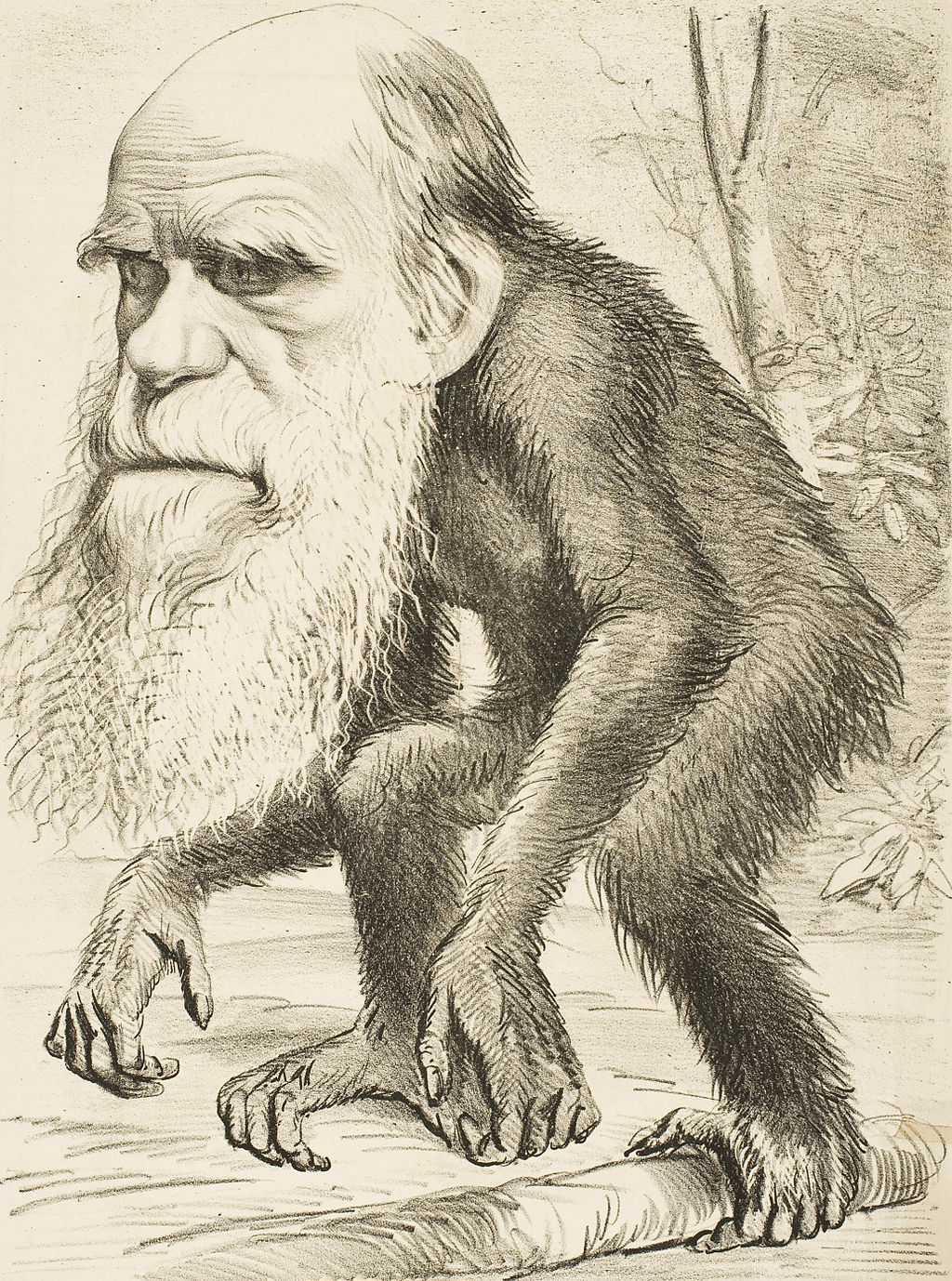 In the 1870s, British caricatures of Darwin with a non-human ape body contributed to the identification of evolutionism with Darwinism.[204] The book aroused international interest[205] and a widespread debate, with no sharp line between scientific issues and ideological, social and religious implications.[206] Much of the initial reaction was hostile, in a large part because very few reviewers actually understood his theory,[207] but Darwin had to be taken seriously as a prominent and respected name in science. Bishop Samuel Wilberforce wrote a review in Quarterly Review in 1860[208] where he disagreed with Darwin's 'argument'. There was much less controversy than had greeted the 1844 publication Vestiges of Creation, which had been rejected by scientists,[205] but had influenced a wide public readership into believing that nature and human society were governed by natural laws.[31] The Origin of Species as a book of wide general interest became associated with ideas of social reform. Its proponents made full use of a surge in the publication of review journals, and it was given more popular attention than almost any other scientific work, though it failed to match the continuing sales of Vestiges.[209] Darwin's book legitimised scientific discussion of evolutionary mechanisms, and the newly coined term 'Darwinism' was used to cover the whole range of evolutionism, not just his own ideas. By the mid-1870s, evolutionism was triumphant.[206] While Darwin had been somewhat coy about human origins, not identifying any explicit conclusion on the matter in his book, he had dropped enough hints about human's animal ancestry for the inference to be made,[210][211] and the first review claimed it made a creed of the "men from monkeys" idea from Vestiges.[212][213] Human evolution became central to the debate and was strongly argued by Huxley who featured it in his popular "working-men's lectures". Darwin did not publish his own views on this until 1871.[214][215] The naturalism of natural selection conflicted with presumptions of purpose in nature and while this could be reconciled by theistic evolution, other mechanisms implying more progress or purpose were more acceptable. Herbert Spencer had already incorporated Lamarckism into his popular philosophy of progressive free market human society. He popularised the terms 'evolution' and 'survival of the fittest', and many thought Spencer was central to evolutionary thinking.[216] Impact on the scientific community See also: History of evolutionary thought Scientific readers were already aware of arguments that species changed through processes that were subject to laws of nature, but the transmutational ideas of Lamarck and the vague "law of development" of Vestiges had not found scientific favour. Darwin presented natural selection as a scientifically testable mechanism while accepting that other mechanisms such as inheritance of acquired characters were possible. His strategy established that evolution through natural laws was worthy of scientific study, and by 1875, most scientists accepted that evolution occurred but few thought natural selection was significant. Darwin's scientific method was also disputed, with his proponents favouring the empiricism of John Stuart Mill's A System of Logic, while opponents held to the idealist school of William Whewell's Philosophy of the Inductive Sciences, in which investigation could begin with the intuitive idea that species were fixed objects created by design.[217] Early support for Darwin's ideas came from the findings of field naturalists studying biogeography and ecology, including Joseph Dalton Hooker in 1860, and Asa Gray in 1862. Henry Walter Bates presented research in 1861 that explained insect mimicry using natural selection. Alfred Russel Wallace discussed evidence from his Malay archipelago research, including an 1864 paper with an evolutionary explanation for the Wallace line.[218] 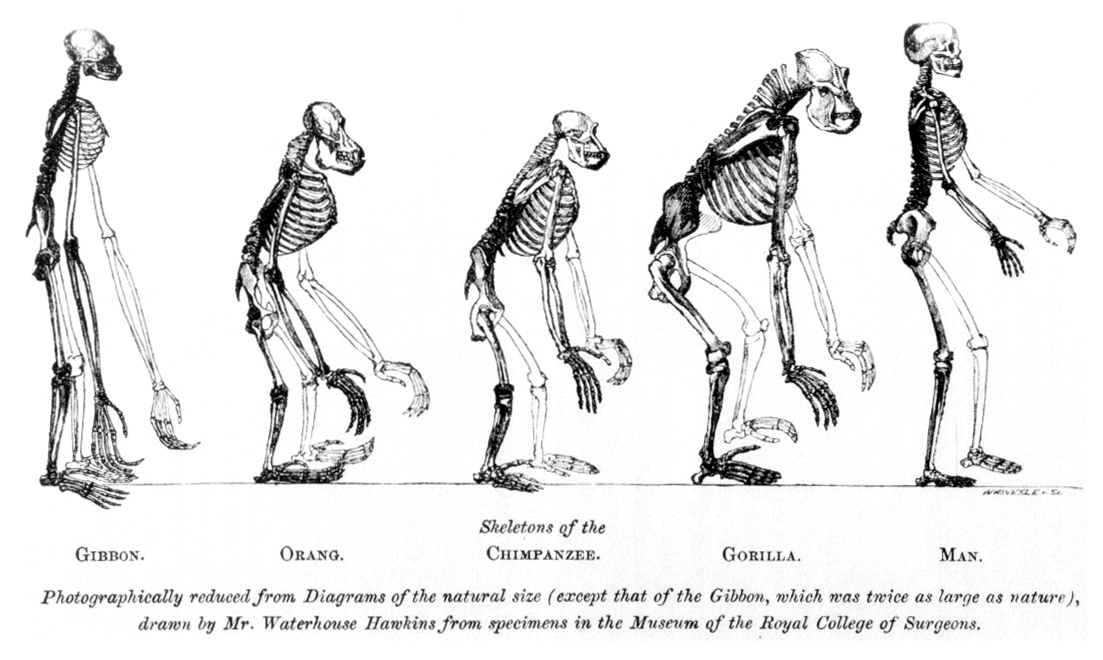 Huxley used illustrations to show that humans and apes had the same basic skeletal structure.[219] Evolution had less obvious applications to anatomy and morphology, and at first had little impact on the research of the anatomist Thomas Henry Huxley.[220] Despite this, Huxley strongly supported Darwin on evolution; though he called for experiments to show whether natural selection could form new species, and questioned if Darwin's gradualism was sufficient without sudden leaps to cause speciation. Huxley wanted science to be secular, without religious interference, and his article in the April 1860 Westminster Review promoted scientific naturalism over natural theology,[221][222] praising Darwin for "extending the domination of Science over regions of thought into which she has, as yet, hardly penetrated" and coining the term "Darwinism" as part of his efforts to secularise and professionalise science.[223] Huxley gained influence, and initiated the X Club, which used the journal Nature to promote evolution and naturalism, shaping much of late-Victorian science. Later, the German morphologist Ernst Haeckel would convince Huxley that comparative anatomy and palaeontology could be used to reconstruct evolutionary genealogies.[220][224] The leading naturalist in Britain was the anatomist Richard Owen, an idealist who had shifted to the view in the 1850s that the history of life was the gradual unfolding of a divine plan.[225] Owen's review of the Origin in the April 1860 Edinburgh Review bitterly attacked Huxley, Hooker and Darwin, but also signalled acceptance of a kind of evolution as a teleological plan in a continuous "ordained becoming", with new species appearing by natural birth. Others that rejected natural selection, but supported "creation by birth", included the Duke of Argyll who explained beauty in plumage by design.[226][227] Since 1858, Huxley had emphasised anatomical similarities between apes and humans, contesting Owen's view that humans were a separate sub-class. Their disagreement over human origins came to the fore at the British Association for the Advancement of Science meeting featuring the legendary 1860 Oxford evolution debate.[228][229] In two years of acrimonious public dispute that Charles Kingsley satirised as the "Great Hippocampus Question" and parodied in The Water-Babies as the "great hippopotamus test", Huxley showed that Owen was incorrect in asserting that ape brains lacked a structure present in human brains.[230] Others, including Charles Lyell and Alfred Russel Wallace, thought that humans shared a common ancestor with apes, but higher mental faculties could not have evolved through a purely material process. Darwin published his own explanation in the Descent of Man (1871).[231] Impact outside Great Britain 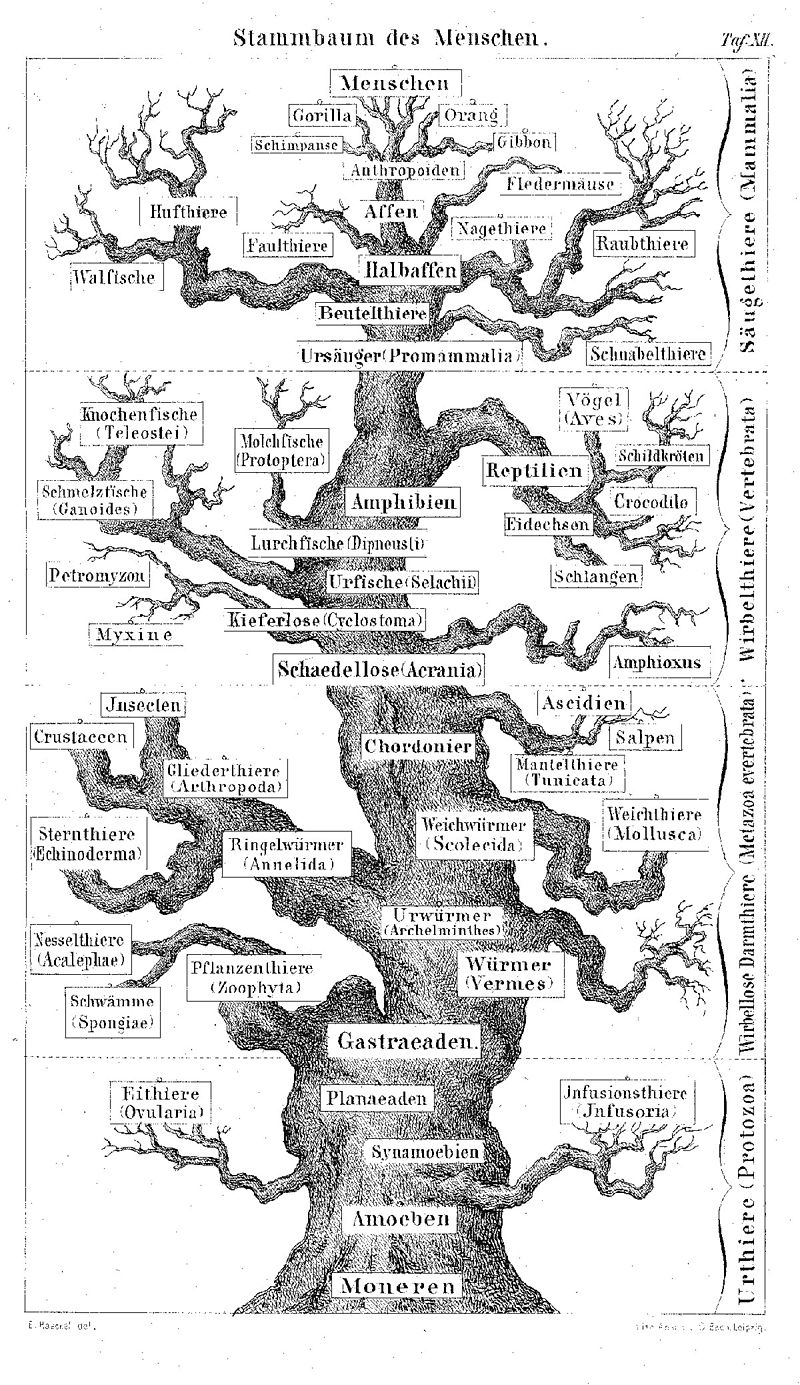 Haeckel showed a main trunk leading to mankind with minor branches to various animals, unlike Darwin's branching evolutionary tree.[232] The German physiologist Emil du Bois-Reymond converted to Darwinism after reading an English copy of On the Origin of Species in the spring of 1860. Du Bois-Reymond was a committed supporter, securing Darwin an honorary degree from the University of Breslau, teaching his theory to students at the University of Berlin, and defending his name to paying audiences across Germany and The Netherlands. Du Bois-Reymond's exposition resembled Darwin's: he endorsed natural selection, rejected the inheritance of acquired characters, remained silent on the origin of variation, and identified "the altruism of bees, the regeneration of tissue, the effects of exercise, and the inheritance of disadvantageous traits" as puzzles presented by the theory.[233] Evolutionary ideas, although not natural selection, were accepted by other German biologists accustomed to ideas of homology in morphology from Goethe's Metamorphosis of Plants and from their long tradition of comparative anatomy. Bronn's alterations in his German translation added to the misgivings of conservatives but encouraged political radicals. Ernst Haeckel was particularly ardent, aiming to synthesise Darwin's ideas with those of Lamarck and Goethe while still reflecting the spirit of Naturphilosophie.[98][234] His ambitious programme to reconstruct the evolutionary history of life was joined by Huxley and supported by discoveries in palaeontology. Haeckel used embryology extensively in his recapitulation theory, which embodied a progressive, almost linear model of evolution. Darwin was cautious about such histories, and had already noted that von Baer's laws of embryology supported his idea of complex branching.[232] Asa Gray promoted and defended Origin against those American naturalists with an idealist approach, notably Louis Agassiz, who viewed every species as a distinct fixed unit in the mind of the Creator, classifying as species what others considered merely varieties.[235] Edward Drinker Cope and Alpheus Hyatt reconciled this view with evolutionism in a form of neo-Lamarckism involving recapitulation theory.[234] French-speaking naturalists in several countries showed appreciation of the much-modified French translation by Clémence Royer, but Darwin's ideas had little impact in France, where any scientists supporting evolutionary ideas opted for a form of Lamarckism.[101] The intelligentsia in Russia had accepted the general phenomenon of evolution for several years before Darwin had published his theory, and scientists were quick to take it into account, although the Malthusian aspects were felt to be relatively unimportant. The political economy of struggle was criticised as a British stereotype by Karl Marx and by Leo Tolstoy, who had the character Levin in his novel Anna Karenina voice sharp criticism of the morality of Darwin's views.[97] Challenges to natural selection There were serious scientific objections to the process of natural selection as the key mechanism of evolution, including Carl Nägeli's insistence that a trivial characteristic with no adaptive advantage could not be developed by selection. Darwin conceded that these could be linked to adaptive characteristics. His estimate that the age of the Earth allowed gradual evolution was disputed by William Thomson (later awarded the title Lord Kelvin), who calculated that the Sun, and therefore life on Earth, was only about 100 million years old.[236] Darwin accepted blending inheritance, but Fleeming Jenkin calculated that as it mixed traits, natural selection could not accumulate useful traits. Darwin tried to meet these objections in the fifth edition. Mivart supported directed evolution, and compiled scientific and religious objections to natural selection. In response, Darwin made considerable changes to the sixth edition. The problems of the age of the Earth and heredity were only resolved in the 20th century.[89][237] By the mid-1870s, most scientists accepted evolution, but relegated natural selection to a minor role as they believed evolution was purposeful and progressive. The range of evolutionary theories during "the eclipse of Darwinism" included forms of "saltationism" in which new species were thought to arise through "jumps" rather than gradual adaptation, forms of orthogenesis claiming that species had an inherent tendency to change in a particular direction, and forms of neo-Lamarckism in which inheritance of acquired characteristics led to progress. The minority view of August Weismann, that natural selection was the only mechanism, was called neo-Darwinism. It was thought that the rediscovery of Mendelian inheritance invalidated Darwin's views.[238][239] Impact on economic and political debates While some, like Spencer, used analogy from natural selection as an argument against government intervention in the economy to benefit the poor, others, including Alfred Russel Wallace, argued that action was needed to correct social and economic inequities to level the playing field before natural selection could improve humanity further. Some political commentaries, including Walter Bagehot's Physics and Politics (1872), attempted to extend the idea of natural selection to competition between nations and between human races. Such ideas were incorporated into what was already an ongoing effort by some working in anthropology to provide scientific evidence for the superiority of Caucasians over non-white races and justify European imperialism. Historians write that most such political and economic commentators had only a superficial understanding of Darwin's scientific theory, and were as strongly influenced by other concepts about social progress and evolution, such as the Lamarckian ideas of Spencer and Haeckel, as they were by Darwin's work. Darwin objected to his ideas being used to justify military aggression and unethical business practices as he believed morality was part of fitness in humans, and he opposed polygenism, the idea that human races were fundamentally distinct and did not share a recent common ancestry.[240] Religious attitudes The book produced a wide range of religious responses at a time of changing ideas and increasing secularisation. The issues raised were complex and there was a large middle ground. Developments in geology meant that there was little opposition based on a literal reading of Genesis,[241] but defence of the argument from design and natural theology was central to debates over the book in the English-speaking world.[242][243] 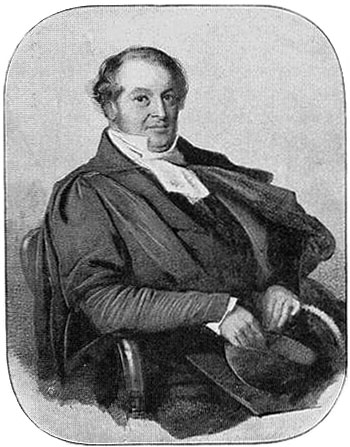 The liberal theologian Baden Powell defended evolutionary ideas by arguing that the introduction of new species should be considered a natural rather than a miraculous process.[244] Natural theology was not a unified doctrine, and while some such as Louis Agassiz were strongly opposed to the ideas in the book, others sought a reconciliation in which evolution was seen as purposeful.[241] In the Church of England, some liberal clergymen interpreted natural selection as an instrument of God's design, with the cleric Charles Kingsley seeing it as "just as noble a conception of Deity".[245][246] In the second edition of January 1860, Darwin quoted Kingsley as "a celebrated cleric", and added the phrase "by the Creator" to the closing sentence, which from then on read "life, with its several powers, having been originally breathed by the Creator into a few forms or into one".[174] While some commentators have taken this as a concession to religion that Darwin later regretted,[84] Darwin's view at the time was of God creating life through the laws of nature,[247][248] and even in the first edition there are several references to "creation".[249] Baden Powell praised "Mr Darwin's masterly volume [supporting] the grand principle of the self-evolving powers of nature".[250] In America, Asa Gray argued that evolution is the secondary effect, or modus operandi, of the first cause, design,[251] and published a pamphlet defending the book in terms of theistic evolution, Natural Selection is not inconsistent with Natural Theology.[245][252][253] Theistic evolution became a popular compromise, and St. George Jackson Mivart was among those accepting evolution but attacking Darwin's naturalistic mechanism. Eventually it was realised that supernatural intervention could not be a scientific explanation, and naturalistic mechanisms such as neo-Lamarckism were favoured over natural selection as being more compatible with purpose.[241] Even though the book did not explicitly spell out Darwin's beliefs about human origins, it had dropped a number of hints about human's animal ancestry[211] and quickly became central to the debate, as mental and moral qualities were seen as spiritual aspects of the immaterial soul, and it was believed that animals did not have spiritual qualities. This conflict could be reconciled by supposing there was some supernatural intervention on the path leading to humans, or viewing evolution as a purposeful and progressive ascent to mankind's position at the head of nature.[241] While many conservative theologians accepted evolution, Charles Hodge argued in his 1874 critique "What is Darwinism?" that "Darwinism", defined narrowly as including rejection of design, was atheism though he accepted that Asa Gray did not reject design.[254][255] Asa Gray responded that this charge misrepresented Darwin's text.[256] By the early 20th century, four noted authors of The Fundamentals were explicitly open to the possibility that God created through evolution,[257] but fundamentalism inspired the American creation–evolution controversy that began in the 1920s. Some conservative Roman Catholic writers and influential Jesuits opposed evolution in the late 19th and early 20th century, but other Catholic writers, starting with Mivart, pointed out that early Church Fathers had not interpreted Genesis literally in this area.[258] The Vatican stated its official position in a 1950 papal encyclical, which held that evolution was not inconsistent with Catholic teaching.[259][260] |
レセプション=受容 こちらも参照: 種の起源』への反応  1870年代、ダーウィンが人間ではない猿のような体つきをしているというイギリスの風刺画が、進化論をダーウィニズムと同一視することに貢献した[204]。 この本は国際的な関心を呼び[205]、科学的な問題とイデオロギー的、社会的、宗教的な意味合いとの間に明確な境界線がないまま、広範な議論を巻き起こ した[206]。初期の反応の多くは敵対的であり、その理由の大部分は、彼の理論を実際に理解している批評家がほとんどいなかったからである[207]。 サミュエル・ウィルバーフォース司教は1860年に『クォータリー・レビュー』誌に書評を寄稿し[208]、ダーウィンの「議論」に同意しなかった。 1844年に出版された『天地創造の痕跡』は科学者たちによって否定されたが[205]、自然や人間社会は自然の法則によって支配されていると信じるよう に幅広い読者に影響を与えた[31]。ダーウィンの著書は、進化のメカニズムに関する科学的な議論を正当化し、「ダーウィニズム」という新しい造語は、 ダーウィン自身の考えだけでなく、進化論全体をカバーするために使われるようになった。1870年代半ばまでに、進化論は勝利を収めた[206]。 ダーウィンは著書の中で人間の起源について明確な結論を述べることはなく、多少おどけた態度をとっていたが、推論がなされるために人間の動物的祖先につい て十分なヒントを落としていた[210][211]。ダーウィンがこれに関する彼自身の見解を発表したのは1871年のことであった[214] [215]。 自然淘汰の自然主義は、自然における目的の推定と対立し、これは神論的進化によって調整することができたが、より進歩や目的を暗示する他のメカニズムの方 が受け入れやすかった。ハーバート・スペンサーはすでにラマルク主義を、進歩的な自由市場の人間社会という一般的な哲学に組み込んでいた。彼は「進化」と 「適者生存」という言葉を普及させ、多くの人々はスペンサーが進化論的思考の中心であると考えていた[216]。 科学界への影響 以下も参照: 進化論の歴史 科学の読者たちは、自然の法則に従う過程を通じて種が変化するという議論をすでに知っていたが、ラマルクの転生的な考えやヴェスティゲスの漠然とした「発 生の法則」は科学的な支持を得ていなかった。ダーウィンは自然淘汰を科学的に検証可能なメカニズムとして提示する一方で、後天的に獲得された性格の遺伝な ど、他のメカニズムも可能であることを認めた。彼の戦略は、自然法則による進化は科学的研究に値するということを確立し、1875年までには、ほとんどの 科学者が進化が起こることを認めたが、自然選択が重要であると考える科学者はほとんどいなかった。ダーウィンの科学的方法についても論争があり、ダーウィ ンの支持者はジョン・スチュアート・ミルの『論理の体系』の経験主義を支持し、反対者はウィリアム・ホイウェルの『帰納的科学の哲学』の観念論を支持し た。1860年にはジョセフ・ダルトン・フッカーが、1862年にはエイサ・グレイが、生物地理学と生態学を研究するフィールド・ナチュラリストの調査結 果を発表した。ヘンリー・ウォルター・ベイツは1861年、昆虫の擬態を自然淘汰によって説明する研究を発表した。アルフレッド・ラッセル・ウォレスは、 ウォレス系統の進化論的説明を行った1864年の論文を含む、マレー諸島の調査から得られた証拠について論じた[218]。  ハクスリーは、ヒトと類人猿が同じ基本的な骨格構造を持っていることをイラストを使って示した[219]。 このような状況にもかかわらず、ハクスリーは進化論に関してダーウィンを強く支持していた。しかし、彼は自然淘汰が新しい種を形成することができるかどう かを示す実験を要求し、種分化を引き起こすのに突然の飛躍がなければダーウィンの漸進主義で十分であるかどうかを疑問視していた。ハクスリーは科学が宗教 的な干渉を受けない世俗的なものであることを望んでおり、1860年4月の『ウェストミンスター・レビュー』誌に掲載された彼の記事は、自然神学よりも科 学的自然主義を推し進め、[221][222]ダーウィンを「科学がまだほとんど浸透していない思想の領域にまで科学の支配を広げている」と賞賛し、科学 の世俗化と専門化を目指す彼の努力の一環として「ダーウィニズム」という言葉を生み出した。 [ハクスリーは影響力を獲得し、Xクラブを発足させ、雑誌『ネイチャー』を使って進化論と自然主義を推進し、ヴィクトリア朝後期の科学の多くを形成した。 その後、ドイツの形態学者エルンスト・ヘッケルは、比較解剖学と古生物学が進化の系譜を再構築するために使用できることをハクスリーに納得させることにな る[220][224]。 イギリスの代表的な博物学者は解剖学者のリチャード・オーウェンであり、彼は1850年代に生命の歴史は神の計画の段階的な展開であるという見解に移行し ていた理想主義者であった[225]。1860年4月の『エジンバラ・レヴュー』誌におけるオーウェンの『起源』の書評は、ハクスリー、フッカー、ダー ウィンを痛烈に攻撃していたが、同時に、自然誕生によって新しい種が出現する連続的な「定められつつあること」における目的論的計画としての進化の一種を 受け入れることを示していた。1858年以来、ハクスリーは類人猿と人間の間の解剖学的類似性を強調し、人間は別の亜種であるというオーウェンの見解に異 議を唱えていた[226][227]。人間の起源をめぐる両者の意見の相違は、伝説的な1860年のオックスフォード進化論論争を取り上げた英国科学振興 協会の会議で前面に出た[228][229]。チャールズ・キングズレーが「大カバ問題」と風刺し、『The Water-Babies』で「大カバテスト」とパロディ化した2年間の険悪な論争において、ハクスリーは、類人猿の脳には人間の脳に存在する構造が欠け ているというオーウェンの主張が間違っていることを示した。 [チャールズ・ライエルやアルフレッド・ラッセル・ウォレスなどの他の人々は、人類は類人猿と共通の祖先を持つが、より高度な精神能力は純粋に物質的な過 程を経て進化したのではないと考えた。ダーウィンは『人間の下降』(1871年)の中で彼自身の説明を発表した[231]。 イギリス国外への影響  ヘッケルは、ダーウィンの枝分かれした進化の木とは異なり、人類につながる主幹と様々な動物への小枝を示した[232]。 ドイツの生理学者エミール・デュ・ボワ=レイモンは、1860年の春に『種の起源』の英語版を読んでダーウィニズムに改宗した。デュボワ=レイモンドは熱 心な支持者で、ダーウィンにブレスラウ大学から名誉学位を与え、ベルリン大学で学生に彼の理論を教え、ドイツとオランダ全土の有料聴衆に彼の名前を弁護し た。デュボワ=レイモンドの説明はダーウィンのものと似ていた。彼は自然淘汰を支持し、後天的特徴の遺伝を否定し、変異の起源については沈黙を守り、理論 が提示するパズルとして「ミツバチの利他主義、組織の再生、運動の効果、不利な形質の遺伝」を挙げた[233]。 自然淘汰ではないものの、進化論的な考え方は、ゲーテの『植物の変態』から形態学における相同性の考え方に慣れ親しんでいた他のドイツの生物学者たちや、 比較解剖学の長い伝統から受け入れられていた。ブロンがドイツ語訳に手を加えたことは、保守派の不安を煽ったが、政治的急進派を勇気づけた。エルンスト・ ヘッケルは特に熱心で、ナチュール哲学の精神を反映しながらも、ダーウィンの思想をラマルクやゲーテの思想と統合することを目指していた[98] [234]。生命の進化の歴史を再構築するという彼の野心的な計画は、ハクスリーに加わり、古生物学の発見によって支持された。ヘッケルは、進化の漸進的 でほとんど直線的なモデルを具現化した復古説において発生学を多用した。ダーウィンはそのような歴史には慎重であり、フォン・ベールの発生学の法則が彼の 複雑な枝分かれの考えを支持していることをすでに指摘していた[232]。 エイサ・グレイは、ルイ・アガシを筆頭とする観念論的なアプローチをとるアメリカの博物学者たちに対して、オリジンを推進し、擁護した。彼はすべての種を 創造主の心の中にある明確な固定単位とみなし、他の人々が単なる品種とみなすものを種として分類した[235]。エドワード・ドリンカー・コープとアル フェウス・ハイアットは、この見解と進化論とを、再現理論を含むネオ・ラマルキズムの形で和解させた[234]。 ロシアではダーウィンが理論を発表する数年前から知識層は進化の一般的な現象を受け入れており、科学者たちはすぐにそれを考慮に入れたが、マルサス的な側 面は比較的重要ではないと考えられていた。闘争の政治経済学は、カール・マルクスやレオ・トルストイによってイギリスのステレオタイプとして批判され、彼 は小説『アンナ・カレーニナ』の登場人物レヴィンにダーウィンの見解の道徳性に対する鋭い批判を言わせている[97]。 自然淘汰への挑戦 進化の重要なメカニズムとしての自然淘汰のプロセスに対しては、カール・ネーゲリの「適応的な利点のない些細な特性は淘汰によって発達することはありえな い」という主張を含め、科学的に重大な異論があった。ダーウィンは、これらが適応的特徴に結びつく可能性があることを認めた。地球の年齢が漸進的進化を可 能にするという彼の推定は、ウィリアム・トムソン(後にケルヴィン卿の称号を授与される)によって論破された。ダーウィンは第5版でこれらの反論に応えよ うとした。ミヴァートは有向進化を支持し、自然淘汰に対する科学的・宗教的反論をまとめた。これに対してダーウィンは第6版にかなりの変更を加えた。地球 の年齢と遺伝の問題は20世紀になって初めて解決された[89][237]。 1870年代半ばまでに、ほとんどの科学者は進化論を受け入れたが、進化は目的的で進歩的であると信じていたため、自然淘汰を脇役に追いやった。ダーウィ ニズムの蝕み」の間の進化論には、新しい種は漸進的な適応ではなく「ジャンプ」によって生じると考えられる「塩類化論」、種が特定の方向に変化する固有の 傾向を持つと主張する正統発生論、後天的に獲得された特性の遺伝が進歩につながるとするネオ・ラマルキズムの形態が含まれていた。自然淘汰が唯一のメカニ ズムであるというアウグスト・ヴァイスマンの少数派の見解は、ネオ・ダーウィニズムと呼ばれた。メンデル遺伝の再発見によって、ダーウィンの見解は無効に なったと考えられていた[238][239]。 経済的・政治的議論への影響 スペンサーのように、貧しい人々のために政府が経済に介入することに反対する議論として自然淘汰からの類推を用いる者もいれば、アルフレッド・ラッセル・ ウォレスのように、自然淘汰が人類をさらに向上させる前に、社会的・経済的不平等を是正し、土俵を平らにするための行動が必要であると主張する者もいた。 ウォルター・バゲホーの『物理学と政治学』(1872年)をはじめとする政治評論の中には、自然淘汰の考え方を国家間や人類間の競争にまで拡大しようとす るものもあった。このような考え方は、人類学に携わる何人かが、白人以外の人種に対する白人の優越性を科学的に証明し、ヨーロッパ帝国主義を正当化しよう とする、すでに進行中の努力に組み込まれていた。歴史家によれば、そのような政治・経済評論家のほとんどは、ダーウィンの科学理論を表面的にしか理解して おらず、ダーウィンの研究と同様に、スペンサーやヘッケルのラマルク的思想など、社会の進歩や進化に関する他の概念からも強い影響を受けていたという。 ダーウィンは、道徳は人間の適性の一部であると信じていたため、自分の考えが軍事的侵略や非倫理的な商習慣を正当化するために使用されることに反対し、多 遺伝子主義、つまり人間の種族は根本的に異なっており、最近の共通の祖先を共有していないという考えに反対していた[240]。 宗教的態度 思想が変化し、世俗化が進む中で、この本はさまざまな宗教的反応をもたらした。提起された問題は複雑で、大きな中間層も存在した。地質学の発展は、創世記 の文字通りの読解に基づく反対がほとんどないことを意味したが[241]、デザインからの議論と自然神学の擁護は、英語圏におけるこの本をめぐる議論の中 心であった[242][243]。  リベラルな神学者であるバーデン・パウエルは、新しい種の導入は奇跡的な過程というよりもむしろ自然な過程と見なされるべきであると主張することによって進化論を擁護していた[244]。 自然神学は統一された教義ではなく、ルイ・アガシズのようにこの本の考え方に強く反対する者もいれば、進化を目的的なものとみなすことで和解を求める者も いた[241]。イングランド国教会では、リベラルな聖職者の中には自然淘汰を神の設計の道具として解釈する者もおり、聖職者チャールズ・キングズレーは 「神についての崇高な概念」とみなしていた。 [1860年1月の第2版では、ダーウィンはキングズレーを「著名な聖職者」として引用し、「創造主によって」というフレーズを最後の一文に追加した。 [174]これを後にダーウィンが後悔した宗教への譲歩とみなす論者もいるが[84]、当時のダーウィンの見解は、神が自然の法則を通して生命を創造する というものであり[247][248]、初版でさえも「創造」への言及がいくつかある[249]。 バーデン・パウエルは「自然の自己進化の力という壮大な原理を支持するダーウィン氏の見事な一冊」と賞賛していた[250]。 アメリカでは、エイサ・グレイが進化は第一の原因である設計の二次的な結果、つまり手口であると主張し[251]、神論的進化論の観点からこの本を擁護す るパンフレット『自然淘汰は自然神学と矛盾しない』を出版した[245][252]。 自然淘汰は自然神学と矛盾しない」[245][252][253] 神学的進化論は人気のある妥協案となり、聖ジョージ・ジャクソン・ミヴァートは進化論を受け入れながらもダーウィンの自然主義的メカニズムを攻撃する人々 の一人であった。最終的には、超自然的な介入は科学的な説明にはなり得ないことが認識され、ネオ・ラマルキズムのような自然主義的なメカニズムが、より目 的に適合するものとして自然淘汰よりも支持されるようになった[241]。 この本は人間の起源についてのダーウィンの信念を明文化していなかったにもかかわらず、人間の動物的祖先について多くのヒントを投げかけており [211]、すぐに議論の中心となった。この対立は、人間に至る道筋に何らかの超自然的な介入があったと仮定するか、あるいは進化を自然の先頭に立つ人類 の地位への目的的かつ漸進的な上昇と見なすことによって調整することができた[241]。多くの保守的な神学者たちが進化論を受け入れた一方で、チャール ズ・ホッジは1874年に発表した評論『ダーウィニズムとは何か? 「254][255]。20世紀初頭までに、『ファンダメンタルズ』の4人の著名な著者は、神が進化論を通して創造したという可能性を明確に受け入れてい たが[257]、ファンダメンタリズムは1920年代に始まったアメリカの創造と進化の論争に影響を与えた。19世紀後半から20世紀初頭にかけて、保守 的なローマ・カトリックの作家や影響力のあるイエズス会の中には進化論に反対する者もいたが、ミヴァルトを始めとする他のカトリックの作家は、初期の教父 たちがこの分野において創世記を文字通りに解釈していなかったことを指摘していた[258]。 バチカンは1950年のローマ教皇の回勅において、進化論はカトリックの教えと矛盾するものではないとする公式の立場を表明した[259][260]。 |
Modern influence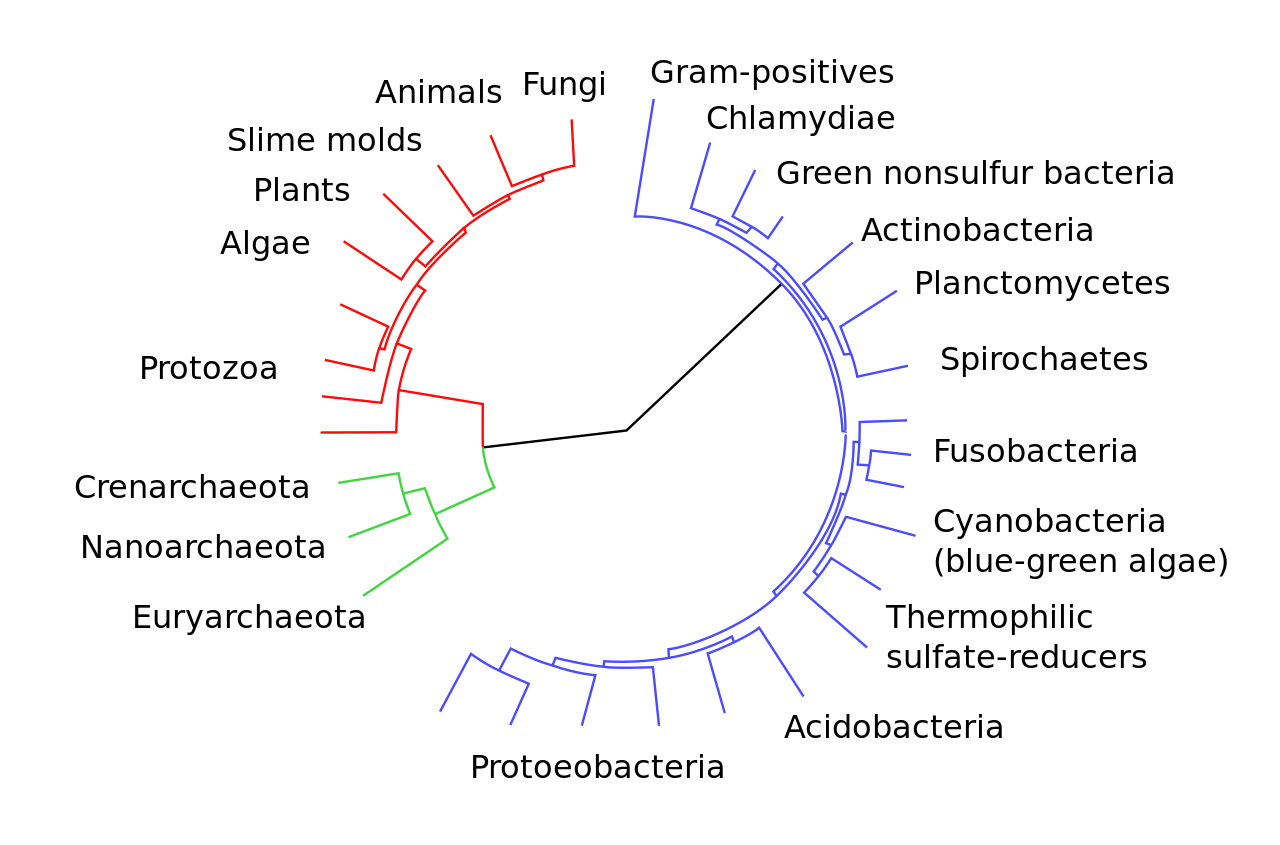 A modern phylogenetic tree based on genome analysis shows the three-domain system. Various alternative evolutionary mechanisms favoured during "the eclipse of Darwinism" became untenable as more was learned about inheritance and mutation. The full significance of natural selection was at last accepted in the 1930s and 1940s as part of the modern evolutionary synthesis. During that synthesis biologists and statisticians, including R. A. Fisher, Sewall Wright and J. B. S. Haldane, merged Darwinian selection with a statistical understanding of Mendelian genetics.[239] Modern evolutionary theory continues to develop. Darwin's theory of evolution by natural selection, with its tree-like model of branching common descent, has become the unifying theory of the life sciences. The theory explains the diversity of living organisms and their adaptation to the environment. It makes sense of the geological record, biogeography, parallels in embryonic development, biological homologies, vestigiality, cladistics, phylogenetics and other fields, with unrivalled explanatory power; it has also become essential to applied sciences such as medicine and agriculture.[261][262] Despite the scientific consensus, a religion-based political controversy has developed over how evolution is taught in schools, especially in the United States.[263] Interest in Darwin's writings continues, and scholars have generated an extensive literature, the Darwin Industry, about his life and work. The text of Origin itself has been subject to much analysis including a variorum, detailing the changes made in every edition, first published in 1959,[264] and a concordance, an exhaustive external index published in 1981.[265] Worldwide commemorations of the 150th anniversary of the publication of On the Origin of Species and the bicentenary of Darwin's birth were scheduled for 2009.[266] They celebrated the ideas which "over the last 150 years have revolutionised our understanding of nature and our place within it".[267] In a survey conducted by a group of academic booksellers, publishers and librarians in advance of Academic Book Week in the United Kingdom, On the Origin of Species was voted the most influential academic book ever written.[268] It was hailed as "the supreme demonstration of why academic books matter" and "a book which has changed the way we think about everything".[269] |
現代の影響 ゲノム解析に基づく現代の系統樹は、3ドメインシステムを示している。 ダーウィニズムの蝕み」の間に支持された様々な代替進化メカニズムは、遺伝や突然変異についてより多くのことがわかるにつれて、成り立たなくなった。自然 淘汰の完全な意義は、1930年代から1940年代にかけて、現代進化総合学の一部として受け入れられるようになった。この統合の間に、R.A.フィッ シャー、セウォール・ライト、J.B.S.ハルデインなどの生物学者や統計学者は、ダーウィン淘汰とメンデル遺伝学の統計的理解を融合させた[239]。 現代の進化論は発展し続けている。ダーウィンの自然淘汰による進化論は、枝分かれする共通進化という樹木のようなモデルを持ち、生命科学の統一理論となっ ている。この理論は、生物の多様性と環境への適応を説明する。地質学的記録、生物地理学、胚発生における類似性、生物学的相同性、痕跡性、クラディス ティックス、系統学、その他の分野においても、比類ない説明力を持つ理論であり、医学や農業などの応用科学にとっても不可欠なものとなっている[261] [262]。科学的コンセンサスにもかかわらず、特にアメリカでは、進化論が学校でどのように教えられているかをめぐって、宗教に基づく政治的論争が展開 されている[263]。 ダーウィンの著作への関心は続いており、学者たちはダーウィンの人生と仕事について、ダーウィン産業と呼ばれる広範な文献を生み出している。種の起源』の出版150周年とダーウィンの生誕200周年を記念する世界的な記念行事が2009年に予定されていた[266]。 イギリスの学術書週間に先立ち、学術書販売者、出版社、図書館員のグループが行った調査では、『種の起源』はこれまで書かれた学術書の中で最も影響力のあ る本に選ばれた[268]。 この本は「学術書がなぜ重要なのかを示す最高の証明」であり、「あらゆるものについての考え方を変えた本」として賞賛された[269]。 |
| On the Origin of Species – full text at Wikisource of the first edition, 1859 The Origin of Species – full text at Wikisource of the 6th edition, 1872 Charles Darwin bibliography History of biology History of evolutionary thought History of speciation Modern evolutionary synthesis The Complete Works of Charles Darwin Online The Descent of Man, and Selection in Relation to Sex, published in 1871; his second major book on evolutionary theory. Transmutation of species |
種の起源 - ウィキソースにある1859年初版の全文 種の起源 - ウィキソースにある第6版(1872年)の全文 チャールズ・ダーウィン書誌 生物学の歴史 進化思想史 種分化の歴史 現代の進化論的統合 チャールズ・ダーウィン全集オンライン 1871年に出版された『人間の下降と性淘汰』。 種の転換 |
| https://en.wikipedia.org/wiki/On_the_Origin_of_Species |
リ ンク
文 献
そ の他の情報
Copyleft, CC, Mitzub'ixi Quq Chi'j, 1996-2099
☆
 ☆
☆